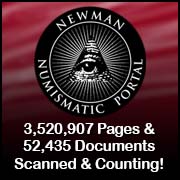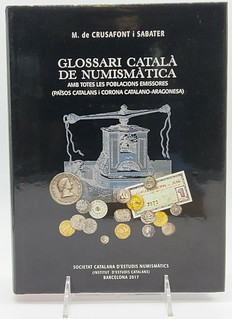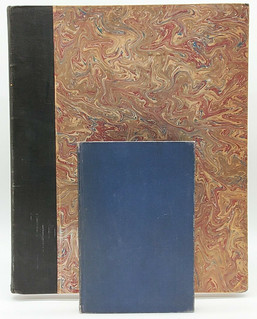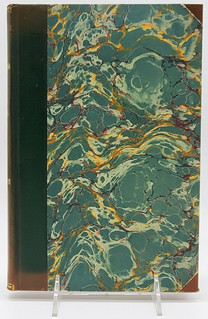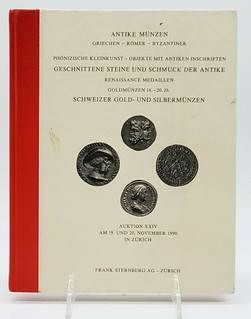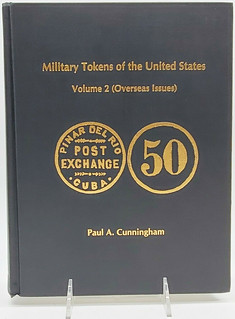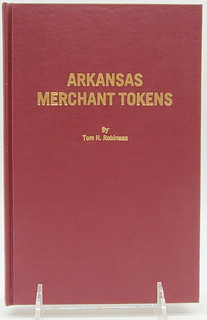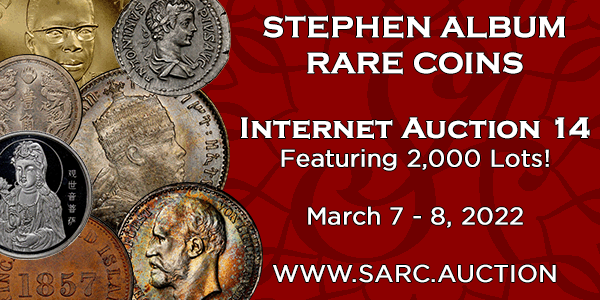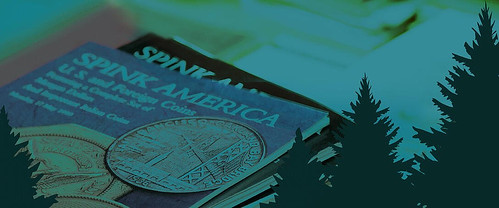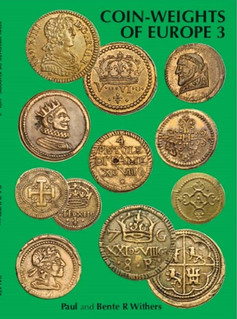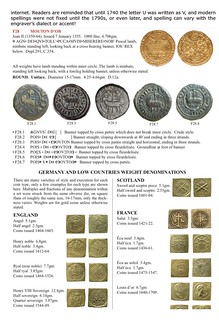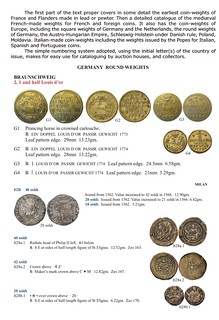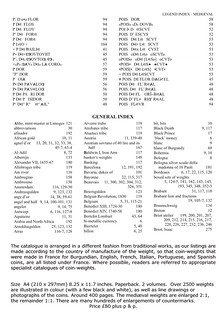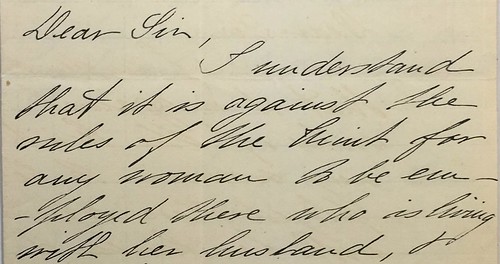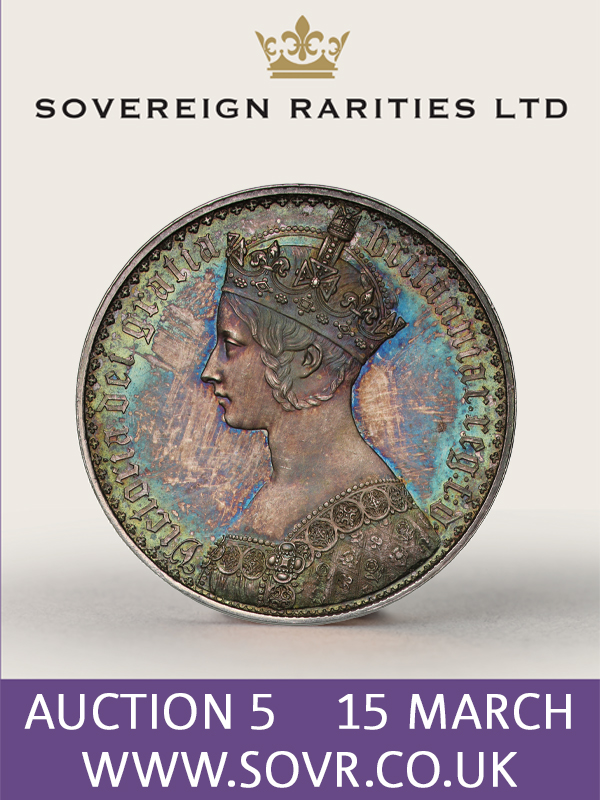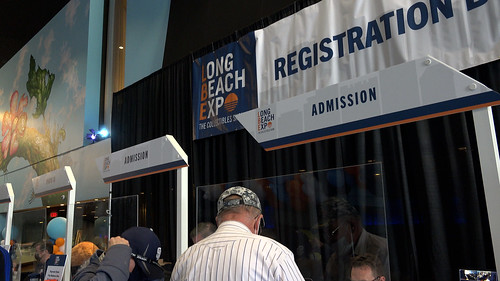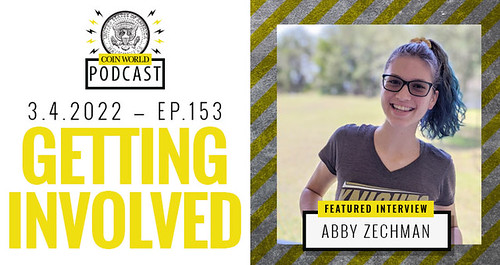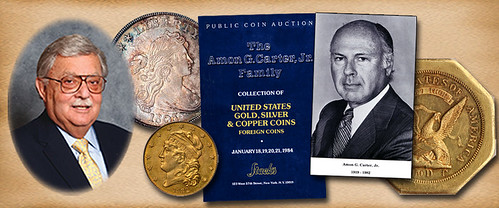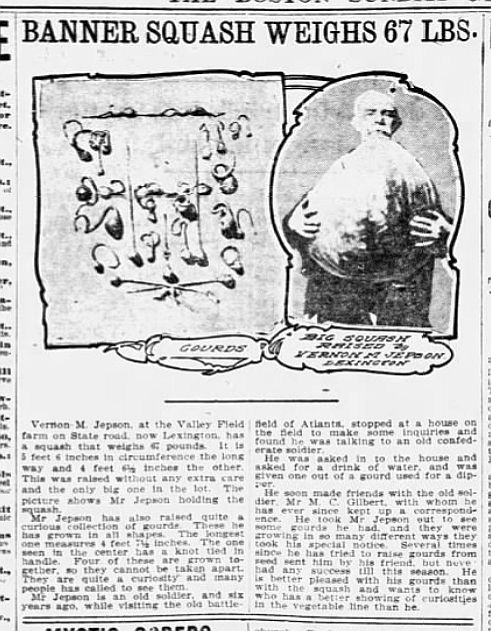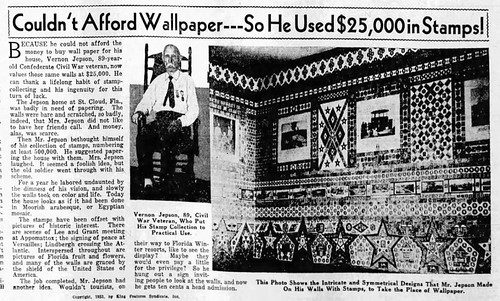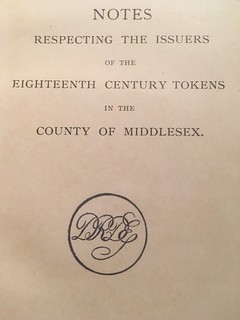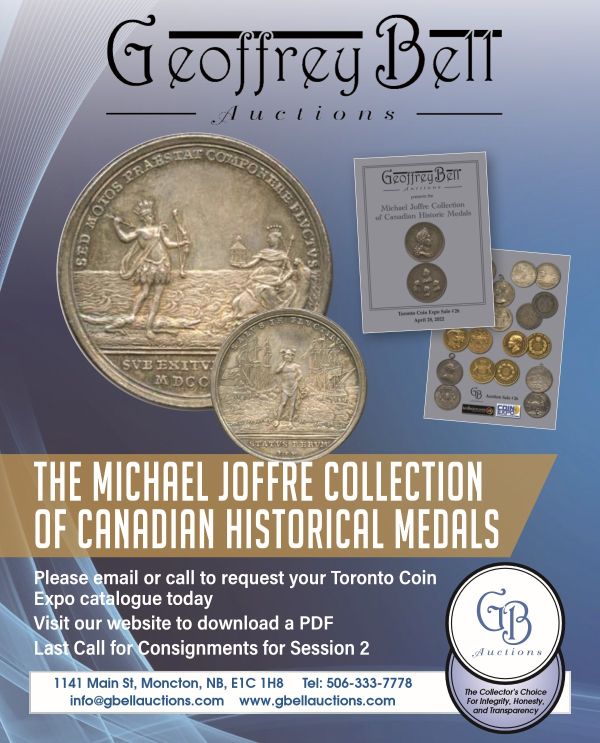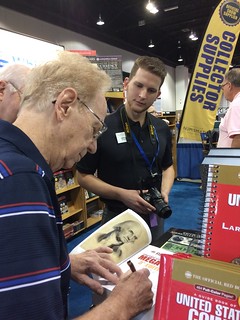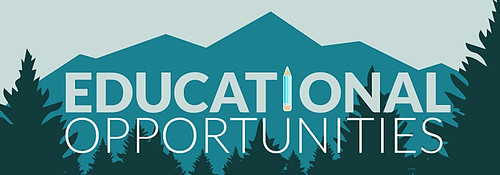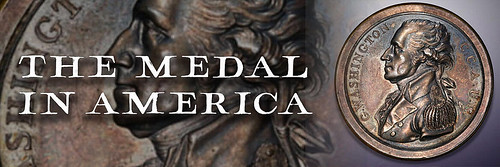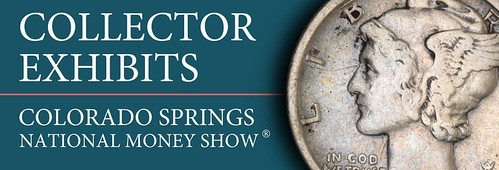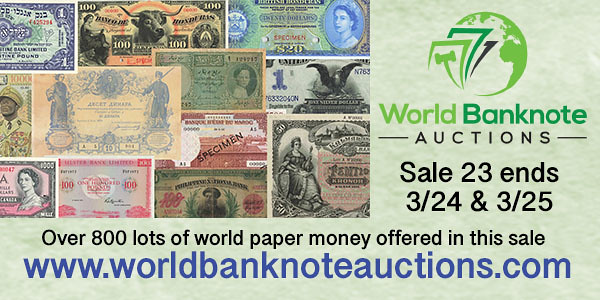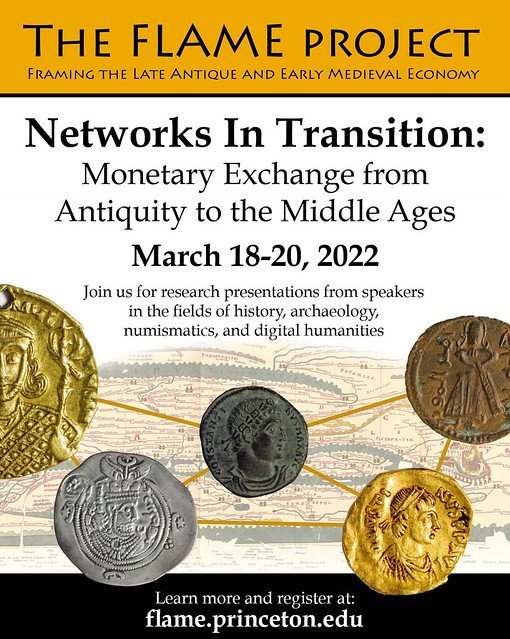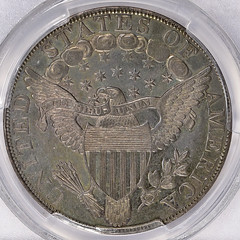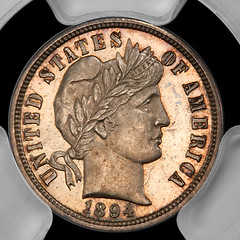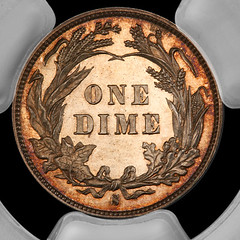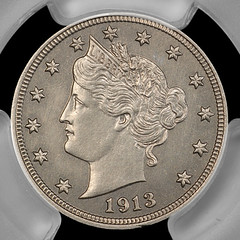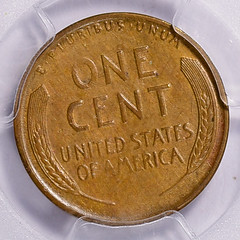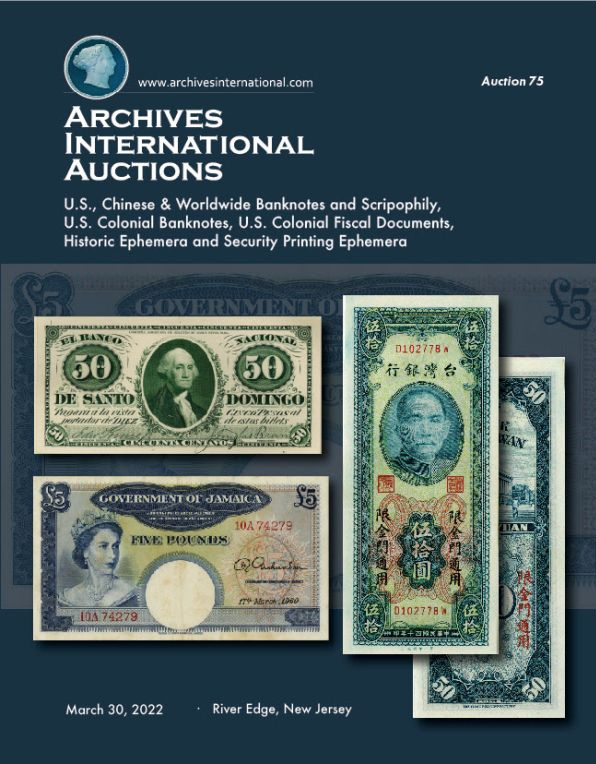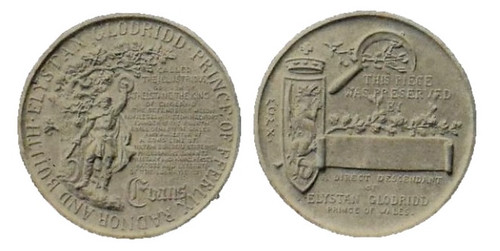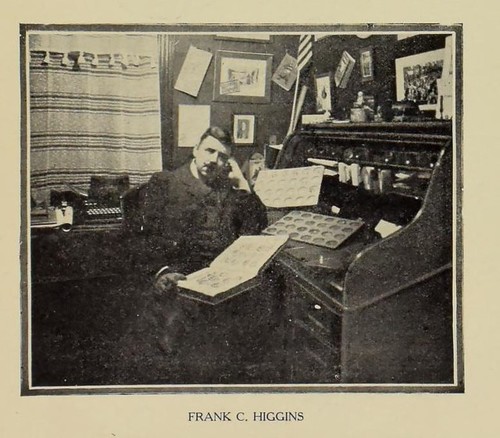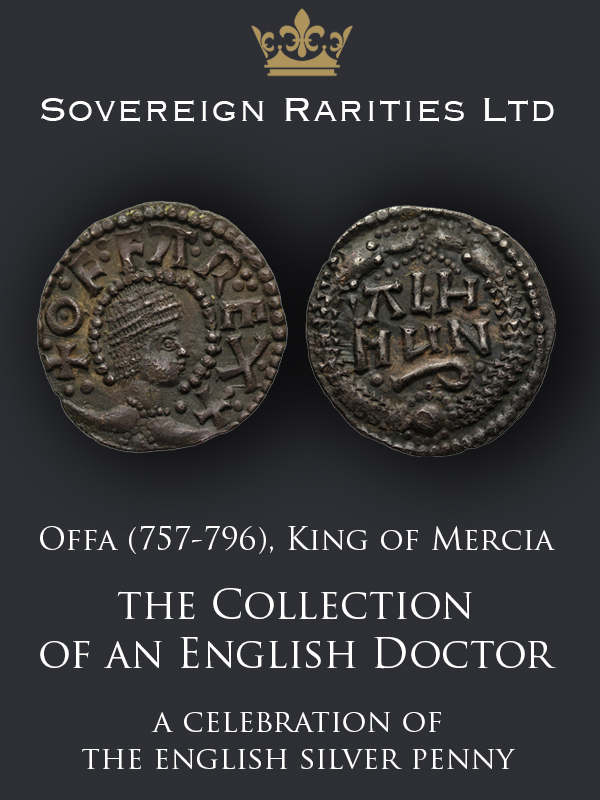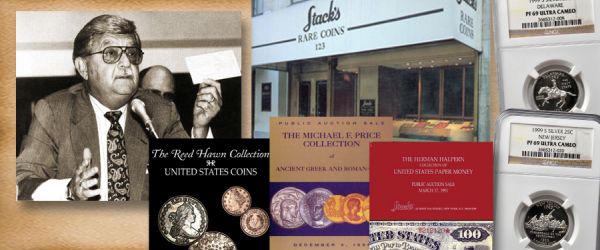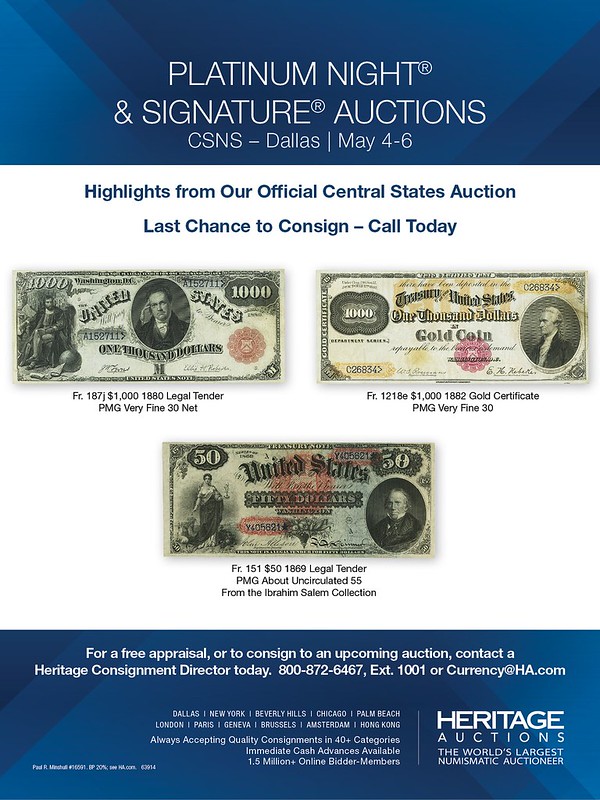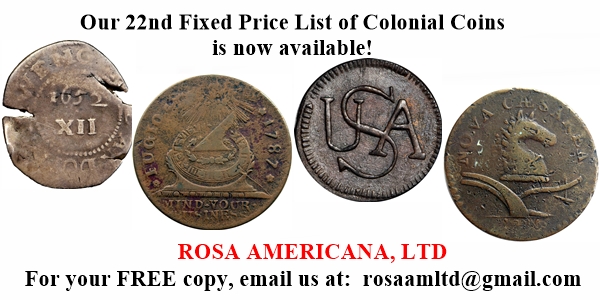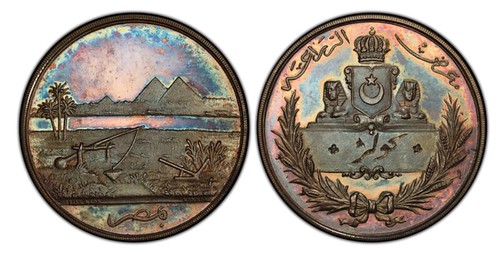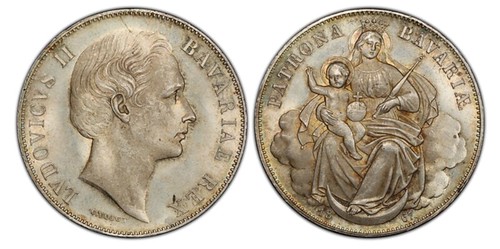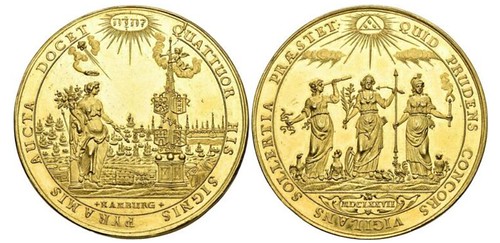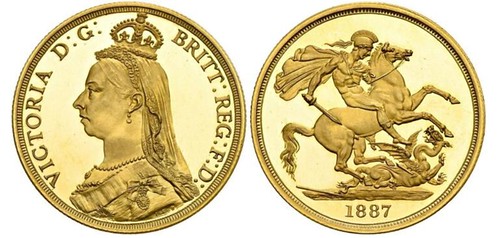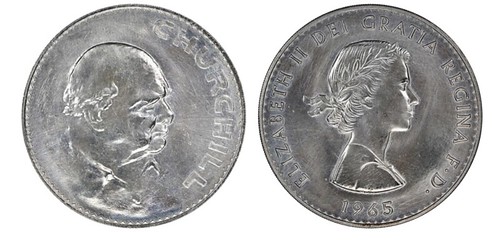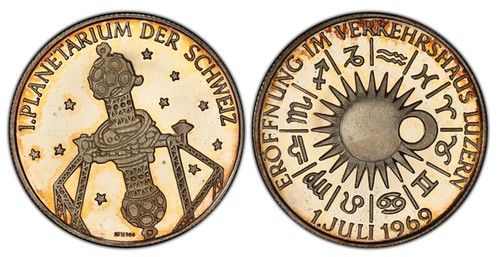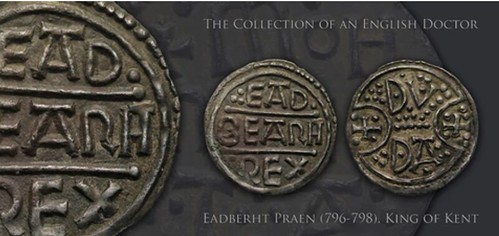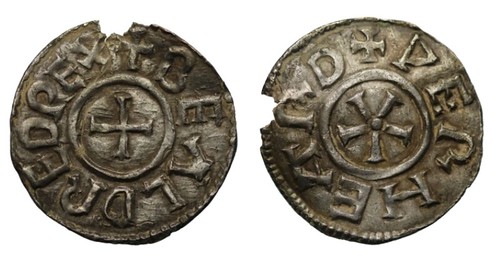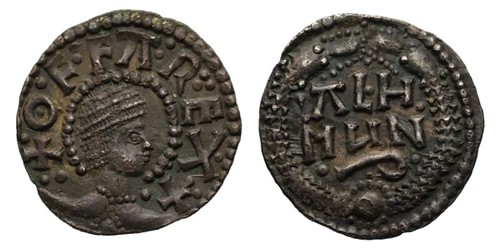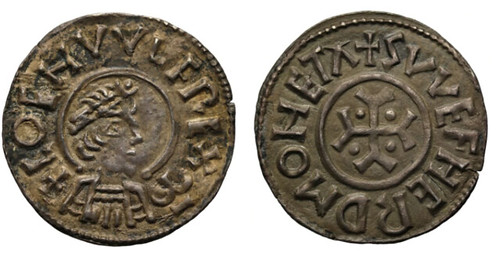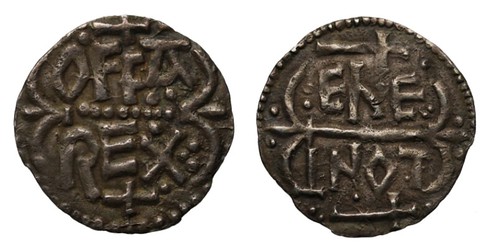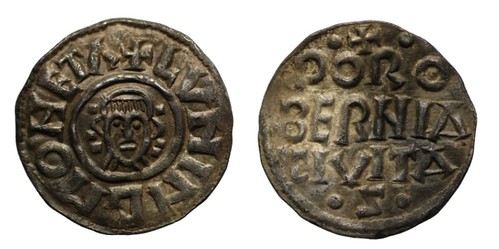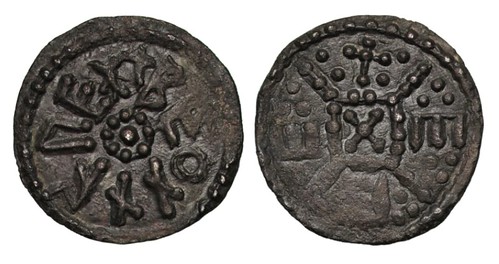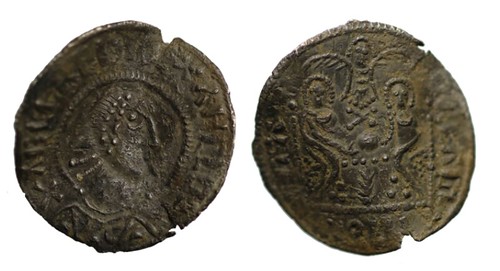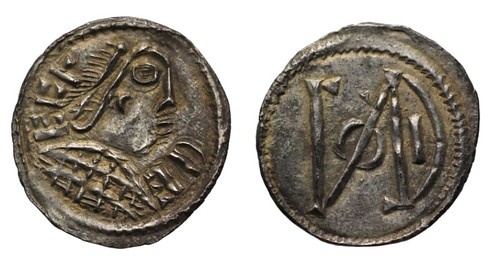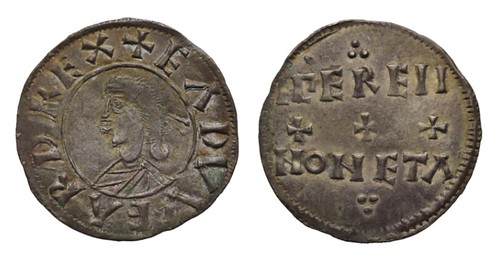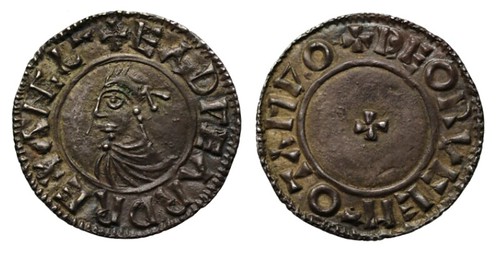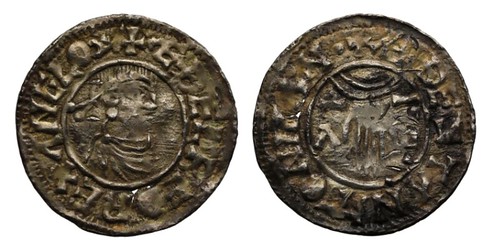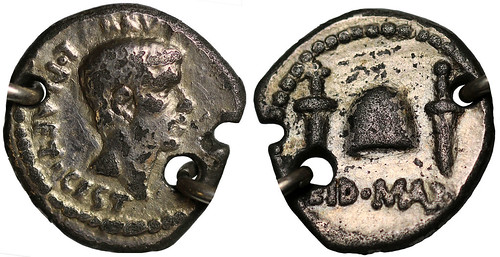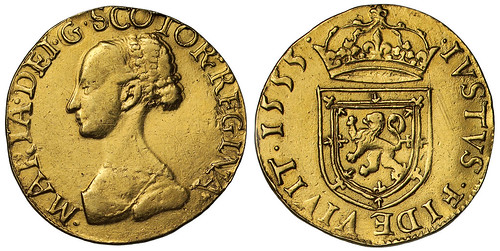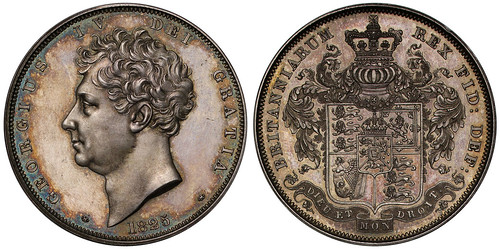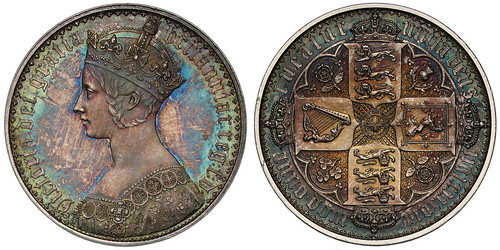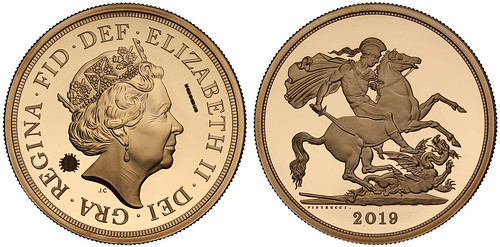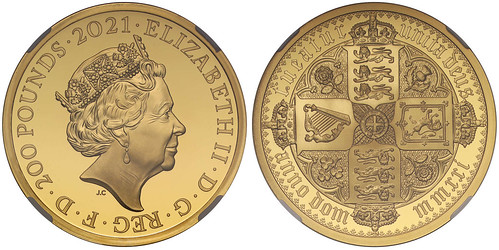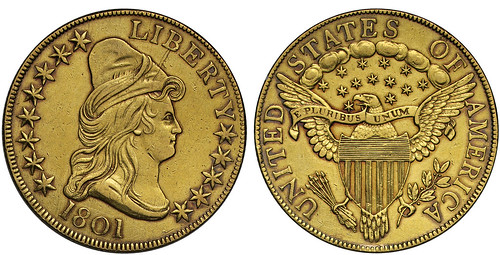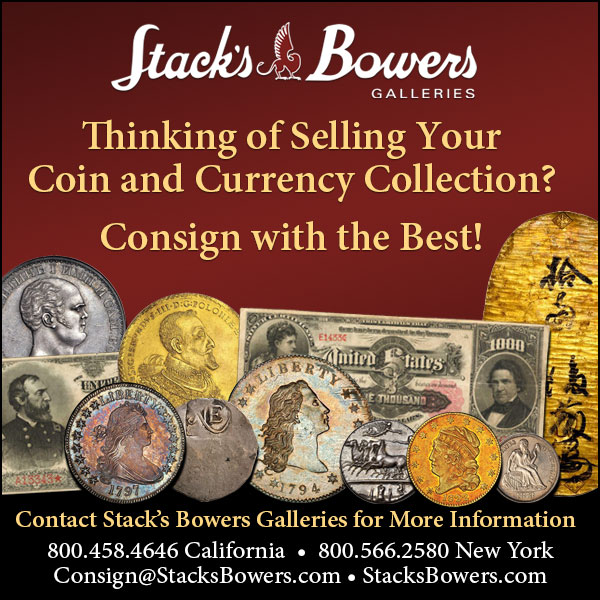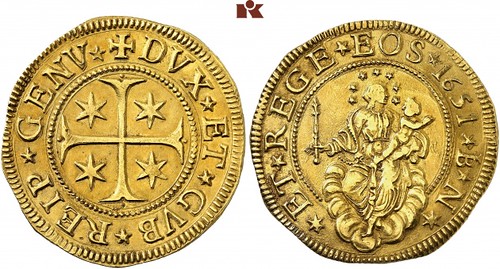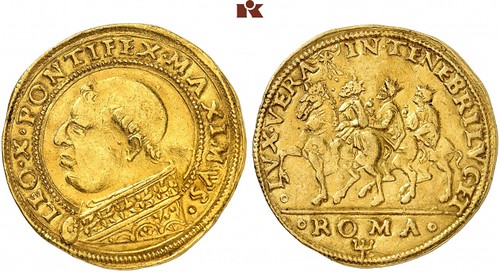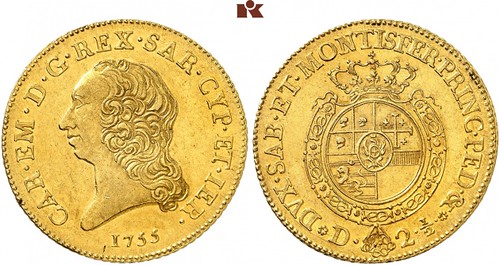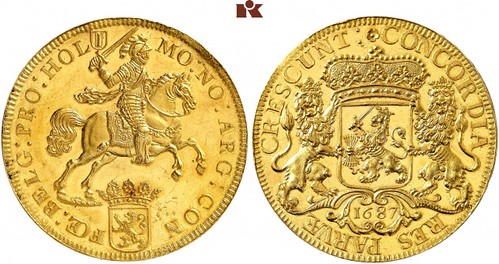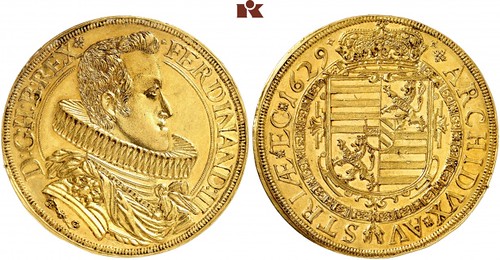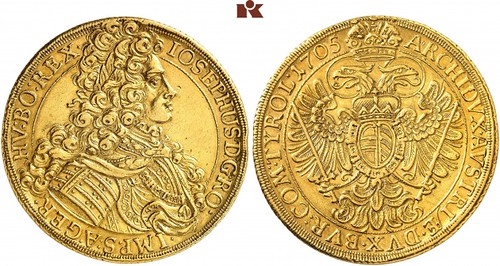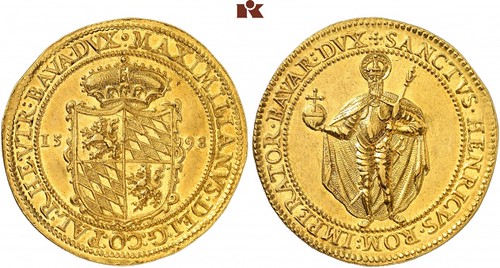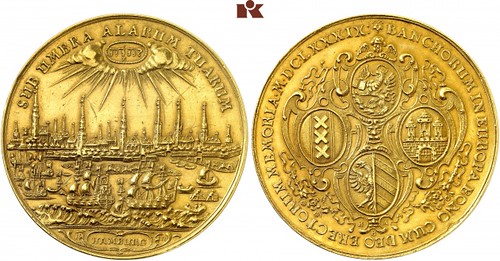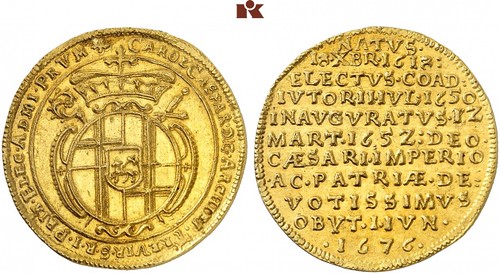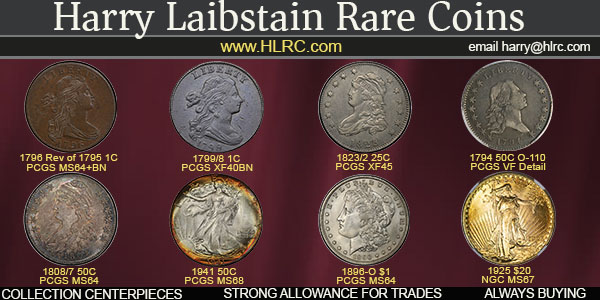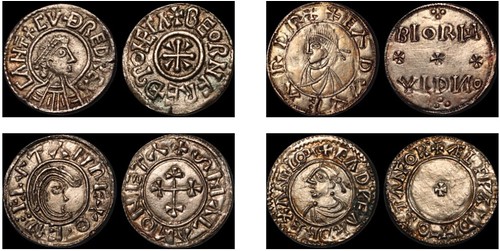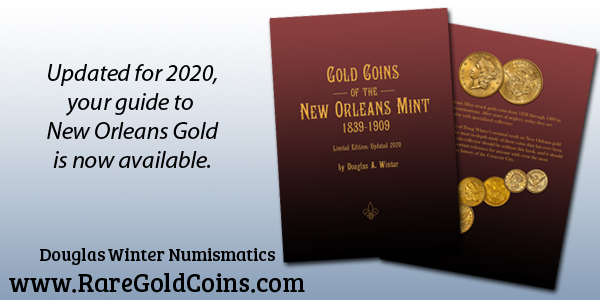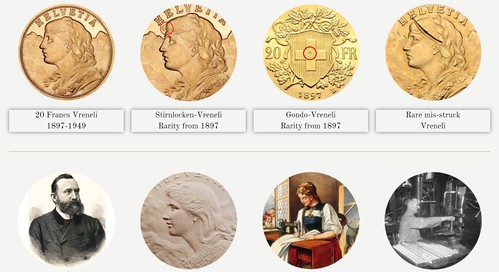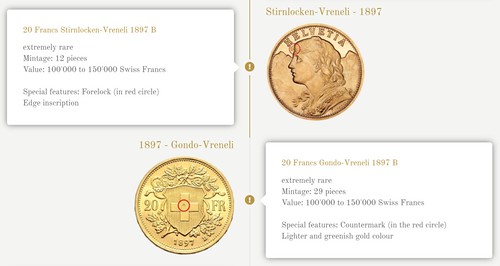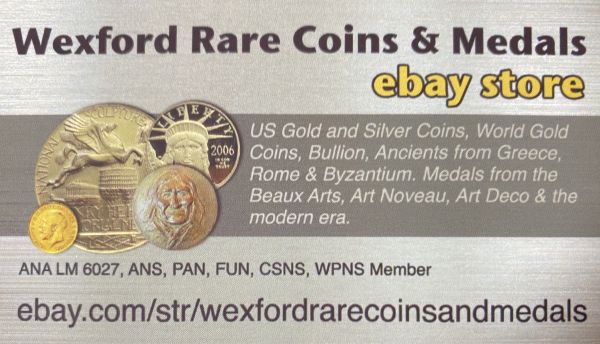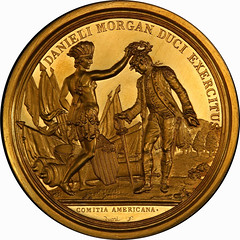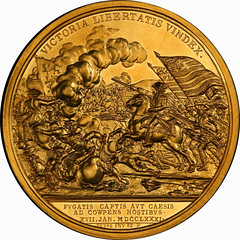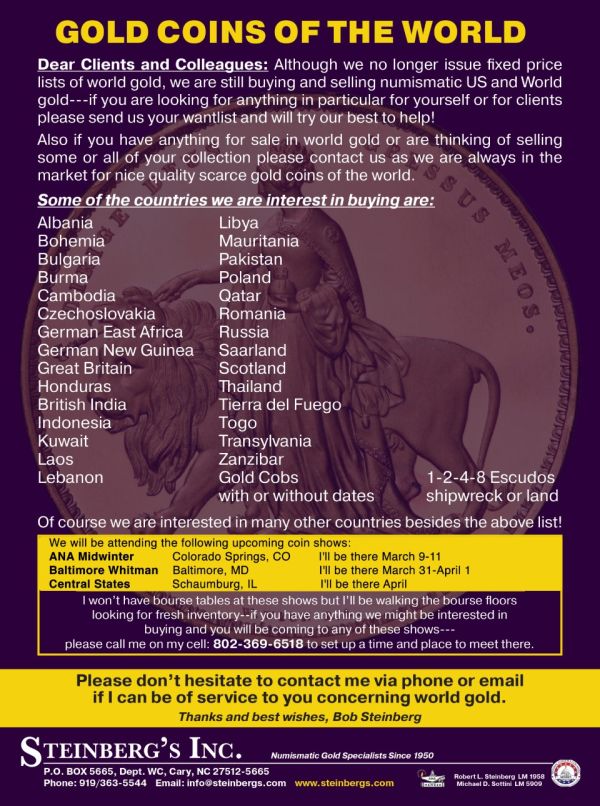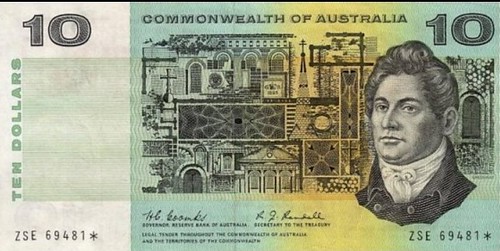
Visit our NBS Sponsors



About UsThe Numismatic Bibliomania Society is a non-profit association devoted to the study and enjoyment of numismatic literature. For more information please see our web site at coinbooks.org SubscriptionsThose wishing to become new E-Sylum subscribers (or wishing to Unsubscribe) can go to the following web page link MembershipThere is a membership application available on the web site Membership Application To join, print the application and return it with your check to the address printed on the application. Print/Digital membership is $40 to addresses in the U.S., and $60 elsewhere. A digital-only membership is available for $25. For those without web access, write to: Charles Heck, Treasurer AsylumFor Asylum mailing address changes and other membership questions, contact Chuck at this email address: treasurer@coinbooks.org SubmissionsTo submit items for publication in The E-Sylum, write to the Editor at this address: whomren@gmail.com BUY THE BOOK BEFORE THE COIN |
- WAYNE'S WORDS: THE E-SYLUM MARCH 6, 2022
- ANS LIBRARY DUPLICATES FOR SALE
- ANA LIBRARY 2022 NATIONAL MONEY SHOW SALE
- NEW BOOK: COIN-WEIGHTS OF EUROPE, VOLS 2-3
- NEW BOOK: WAYS AND MEANS
- NEW BOOK: THE FOUNDERS' FORTUNES
- MARRIED WOMEN UNWELCOME AT THE MINT
- VIDEO: SPRING 2022 LONG BEACH EXPO
- AUDIO: ABBY ZECHMAN INTERVIEW
- MORE NUMISMATICS IN TV AND MOVIES
- MORE ON VERNON M. JEPSON
- NOTES FROM E-SYLUM READERS: MARCH 6, 2022
- ANCIENT COINS WITH KENNETH BRESSETT
- 2022 NATIONAL MONEY SHOW EXHIBITS AND TALKS
- CONFERENCE: NETWORKS IN TRANSITION
- CENTRAL STATES U.S. RARITIES DISPLAY
- VOCABULARY TERM: HUB, HOB
- FRANCIS CARLOS HIGGINS (1867-1928)
- HARVEY STACK'S NUMISMATIC FAMILY, PART 116
- DON EVERHART'S CAREER IN COINS, PART 6
- ATLAS NUMISMATICS MARCH 2022 SELECTIONS
- COLLECTION OF AN ENGLISH DOCTOR, PART ONE
- SOVEREIGN RARITIES IDES OF MARCH SALE
- KÜNKER SALTON COLLECTION GOLD COINS
- DIX NOONAN WEBB OFFERS RARE GOLD THRYSMA
- DAVISSONS AUCTION 41 ELECTROTYPES
- THE SWISS VRENELI
- GOLD DANIEL MORGAN COMITIA AMERICANA MEDAL
- PRINCE, THE WATCHDOG OF THE BANK
- THE MONEY FORGER HONORED ON A BANKNOTE
- CHINESE MAN SPENT HAND-DRAWN BANKNOTES
Click here to read the thin version on the web
Click here to subscribe
Click here to access the complete archive
To comment or submit articles, reply to whomren@gmail.com
Content presented in The E-Sylum is not necessarily researched or independently fact-checked, and views expressed do not necessarily represent those of the Numismatic Bibliomania Society.
WAYNE'S WORDS: THE E-SYLUM MARCH 6, 2022
 We have no new subscribers this week.
We now have 6,960 subscribers.
We have no new subscribers this week.
We now have 6,960 subscribers.
Thank you for reading The E-Sylum. If you enjoy it, please send me the email addresses of friends you think may enjoy it as well and I'll send them a subscription. Contact me at whomren@gmail.com anytime regarding your subscription, or questions, comments or suggestions about our content.
This week we open with numismatic library duplicate sales, three new books, updates from the Newman Numismatic Portal, numismatics in television and movies, and more.
Other topics this week include the Long Beach Expo, the ANA's National Money Show, Central States, Vernon Jepson, Ken Bressett, Frank Higgins, Don Everhart, auction and fixed price previews (numismatic eye candy!), the Swiss Vrneli, the Daniel Morgan Comitia Americana medal in gold, and the forger honored on a banknote.
To learn more about military tokens, coin weights, unmarried women at the Mint, Greenbacks, Abby Zechman, Jerry Buss, the room wallpapered with stamps, Dutch-Israel gold fantasy coins, the Little Tramp, the 1894-S dime, hubs and hobs, the March of Dimes commemorative, electrotypes, and Prince the bank watchdog, read on. Have a great week, everyone!
Wayne Homren
Editor, The E-Sylum
ANS LIBRARY DUPLICATES FOR SALE
The American Numismatic Society is continuing its eBay sales of library duplicates. Here's the latest announcement. -Editor
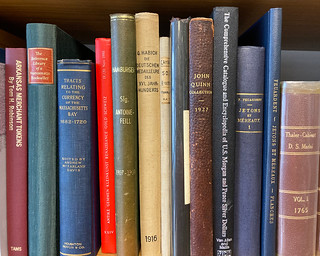 Lots of books, auction catalogs, and fixed price lists will be coming up for sale in March and beyond as we continue to sell duplicates to benefit the ANS Library. These include classic works, like Feuardent on jetons (1904–1915) and Madai on thalers (1765–1774), as well as early catalogs from Ciani, Thieme, Naville, Scott, Ratto, Schlessinger, Ars Classica, and Hamburger. So keep an eye on our eBay store, or, better yet, register and save your searches so you are notified when items you want are listed.
Lots of books, auction catalogs, and fixed price lists will be coming up for sale in March and beyond as we continue to sell duplicates to benefit the ANS Library. These include classic works, like Feuardent on jetons (1904–1915) and Madai on thalers (1765–1774), as well as early catalogs from Ciani, Thieme, Naville, Scott, Ratto, Schlessinger, Ars Classica, and Hamburger. So keep an eye on our eBay store, or, better yet, register and save your searches so you are notified when items you want are listed.
Here are some sample items - see the complete offerings online. Some very useful titles here. -Editor
Ex-ANS Library copy of GLOSSARI CATALÀ DE NUMISMÀTICA AMB TOTES LES POBLACIONES EMISSORES. De Crusafont i Sabater, M. 2017.
Ex-ANS Library copy of SCHAU-UND DENKMÜNZEN MARIA THERESIAS. Probszt-Ohstorff, Günther. 1970.
Ex-ANS Library copy of NUMISMATISCHES WAPPEN-LEXICON DES MITTELALTER UND DER NEUZEIT. Rentzmann, W. 1924. This is a lot of two (2) books, and contains both the larger book as well as the smaller index.
Ex-ANS Library copy of JOSEPH HAMBURGER AUCTION DR. ANTOINE-FEILL COLLECTION. Hamburger, Joseph. 1907. Münzen- und Medaillen-Sammlung des Herrn Dr. Antoine-Feill, Hamburg. Münzen und Medaillen von Dänemark, Norwegen, Schweden, Polen. November 7, 1907.
Ex-ANS Library copy of TALER UND SCHAUTALER DES ERZHAUSES HABSBURG 1484-1896. Voglhuber, Rudolf. 1971.
Ex-ANS Library copy of FRANK STERNBERG AUCTION XXIV. Sternberg, Frank. 1990. Antike Münzen, Griechen, Römer, Byzantiner, Phönizische Kleinkunst, Objekte mit Antiken Inschriften, Geschliffene Steine ??und Schmuck der Antike, Renaissance Medaillen, Goldmünzen, Schweizer Gold- und Silbermünzen. November 19 and 20, 1990.
Ex-ANS Library copy of MILITARY TOKENS OF THE UNITED STATES VOLUME 2 (OVERSEAS ISSUES). Cunningham, Paul A. 1998.
Ex-ANS Library copy of ARKANSAS MERCHANT TOKENS. Robinson, Tom H. 1985.
To see the complete listings:
Items for sale fromamerican-numismatic-society american-numismatic-society
(https://www.ebay.com/sch/american-numismatic-society/m.html?_nkw=&_armrs=1&_ipg=&_from=)
ANA LIBRARY 2022 NATIONAL MONEY SHOW SALE
The American Numismatic Association Dwight N. Manley Library will hold a sale of duplicates during the upcoming National Money Show in Colorado Springs. CO. -Editor
 Visit ANA headquarters during the National Money Show for the chance to score some great book deals from the ANA library.
Visit ANA headquarters during the National Money Show for the chance to score some great book deals from the ANA library.
The book sale – an event usually only available to Summer Seminar attendees – will include duplicate books, auction catalogs and periodicals from the library and will be sold at or below current market price.
The sale will take place March 10-12, 4:30 to 7:30 p.m. daily. All proceeds from the book sale will go toward building the library's holdings and improving the facilities.
To read the complete article, see:
Dwight N. Manley Numismatic Library
(https://www.money.org/library)
NEW BOOK: COIN-WEIGHTS OF EUROPE, VOLS 2-3
Paul (and Bente Withers) of Galata in Wales write:
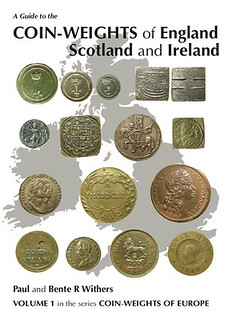 "Over the last two years we have been working on a dream project, that of writing a work on the coin-weights of Europe. This began with A guide to the coin-weights of England, Scotland and Ireland
which introduces the subject to coin collectors who may be unfamiliar with coin-weights, and others who encounter them and are puzzled by them. This is a guide, rather like the Stanley Gibbons simplified stamp catalogue; wherein the major types are listed, but not the minor varieties.
"Over the last two years we have been working on a dream project, that of writing a work on the coin-weights of Europe. This began with A guide to the coin-weights of England, Scotland and Ireland
which introduces the subject to coin collectors who may be unfamiliar with coin-weights, and others who encounter them and are puzzled by them. This is a guide, rather like the Stanley Gibbons simplified stamp catalogue; wherein the major types are listed, but not the minor varieties.
Reference numbers are identical with those used in our 1993 publication British Coin-Weights. Previously unpublished items are given new numbers in curly brackets {xxx} The two-page Glossary section is designed for the use of a wide range of readers of many nationalities, some of whom may have a limited English vocabulary, and perhaps also limited knowledge of coins and numismatic terms. It is also a listing of the more common words relating to coin-weights, in English, French, and German. Finally, there is a two-page index.
Due to the advances in typesetting and printing since 1993 this we are able to offer this 98 page, A4 paperback, illustrated in colour throughout, plus some b&w photos and line drawings. Well over 650 items are illustrated life-size, with more than 20 enlargements of details, and 19 illustrations of boxes, labels and rocker balances, etc., for just £22.00 plus p & p.
Now, within a few weeks of publication the final two volumes in the set are undergoing the last touches of proof-reading and preparation, not exactly an easy task because they have been achieved with the co-operation of many people and institutions.
Much previously un-published information is available here.
The first of the two volumes begins with an appreciation of Adolphe Dieudonné the exceptional French numismatist who wrote the first book on coin-weights very nearly a century ago. Its publication also coincides with our recent golden wedding, and my 80th birthday which will be on the same day as the Queen celebrates her birthday in her record-breaking reign."
Congratulations on all counts! Here is the press release announcing the two new volumes. -Editor
Following the publication last year of A Guide to the COIN-WEIGHTS of England, Scotland and Ireland we are about to publish the final two volumes in the series Coin-Weights of Europe.
We have been collecting coin-weights for almost fifty years. As a result of which we have compiled these two volumes with the aid of many people and organisations including museums, auction houses, fellow dealers, collectors, archaeologists, researchers, and numismatists in the UK, the Netherlands, Denmark, Germany, Belgium, France, and Italy. As a result, these two volumes are result of a life-time's study and effort, not just by us, but by many others as well.
Above all, the work has three main features - it has literally thousands of life-size, or enlarged colour illustrations, it has photo's or line drawings of the coins the coin-weights were intended to check, and it is in English.
The first volume begins with 30 pages designed to give the novice collector who may not be familiar with the subject, information to put him, or her, into the scene, including: a short history, important or useful information such as a list of French kings with their dates of reign, and details of the French (pre-metric) weight system. There is a list of the French and foreign coins for which coin-weights were made in France, together with information about their weights, fineness, dates of issue etc.
It has the French mint identification letters from 1540 until 1890. A table of weights stated on French coin-weights with their gram equivalents. For the reader unfamiliar with French coins the coins are identified by using red numbers indicating weights for gold coins, blue for silver coins, and green for bullion weights. There is a four page glossary which is designed for the use of a wide range of readers of several nationalities, some of whom may have a limited English vocabulary, and perhaps also a limited knowledge of coins and numismatic terms. It is a list of the more common words relating to French and other coin-weights, their English equivalents and vice versa. Amazingly, some pertinent words relating to coin-weights can't even be found on the internet. Readers are reminded that until 1740 the letter U was written as V, and modern spellings were not fixed until the 1790s, or even later, and spelling can vary with the engraver's dialect or accent!
The first part of the text proper covers in some detail the earliest coin-weights of France and Flanders made in lead or pewter. Then a detailed catalogue of the mediæval French-made weights for French and foreign coins. It also has the coin-weights of Europe, including the square weights of Germany and the Netherlands, the round weights of Germany, the Austro-Hungarian Empire, Schleswig-Holstein under Danish rule, Poland, Moldavia. Italian-made coin-weights including the weights issued by the Popes for Italian, Spanish and Portuguese coins.
The simple numbering system adopted, using the initial letter(s) of the country of issue, makes for easy use for cataloguing by auction houses, and collectors.
The sections on the square coin-weights of the Netherlands and Germany are basically a very good, if not the best identification guide to the weights - similar to our ‘Lions, Ships and Angels' book. Although there is much information freely available on the internet, it is often neither full, nor reliable, but what you read in our book is trustworthy and based on the very latest information from serious researchers and experts in the Netherlands and Belgium.
The coin-weights of Italy are covered in a simplified way (by major type, not minor varieties).
Plain weights with a knob (knop), or pin on top are not generally listed in our books. We leave them out as they are neither rare nor unusual, simply plain and less interesting. However, some weights of this kind are included along with pictures of weights in boxes and the scales, to tell a little more of the fascinating story of weights and weighing.
The second volume has detailed coverage of the post-mediæval round and square coin.weights of France. Countermarks from the City of Lyon (and other places) are illustrated enlarged (with references to Lavagne) along with those from other French mints.
It also has:
- a short essay: Bullion flows and their impact on bimetallic currency values in Europe, c.1300-1800 by Oisi´n Mac Conamhna,
- the Statutes and Regulations of June 1668 regarding the working practices of the master scale-makers of the city of Lyon,
- a map of the precious metal assay regions and hall marks of France,
- a comprehensive bibliography,
- a table of weights stated on French coin-weights and gram equivalents,
- a specialist legend index - 8 pages of two-column text,
- a five page (3 column) general index.
A major feature of both volumes is that the type-setting matches as closely as possible the relative sizes and styles of the legends on the weights, including laterally reversed (and upside-down) lettering and special characters.
The catalogue is arranged in a different fashion from traditional works, as our listings are made according to the country of manufacture of the weight, so that coin-weights that were made in France for Burgundian, English, French, Italian, Portuguese, and Spanish coins, are all listed under France. Where possible, readers are referred to appropriate specialist catalogues of coin-weights.
Size A4 (210 x 297mm) 8.25 x 11.7 inches. Paperback. 2 volumes. Over 2500 weights are illustrated in colour (with a few black and white), as well as line drawings or photographs of the coins. Around 400 pages. The mediæval weights are enlarged 2:1, the remainder 1:1. There are many hundreds of enlargements of countermarks.
Price £80 plus p & p.
For more information, or to order, see:
Coin-Weights of Europe, vols. 2 and 3
(https://www.galata.co.uk/coin-weights-of-europe)
NEW BOOK: WAYS AND MEANS
Last week I almost published a Wall Street Journal review of a new book by Roger Lowenstein on the financing of the U.S. Civil War. I decided not to because the review of Ways and Means had nothing to say about the numismatics of the war. But in a new article this week, an excerpt from the book, Lowenstein discusses the creation of Greenbacks - "How Paper Money Saved the Union." Here's an excerpt. -Editor
 Early in the Civil War, a New York congressman named Elbridge Spaulding had a terrible thought. What if the government were to print pieces of paper and call them money? Paper bills existed, of course, issued by scores of private banks. But they were only IOUs; they had no legal standing. As such, merchants and others could refuse them or mark them down.
Early in the Civil War, a New York congressman named Elbridge Spaulding had a terrible thought. What if the government were to print pieces of paper and call them money? Paper bills existed, of course, issued by scores of private banks. But they were only IOUs; they had no legal standing. As such, merchants and others could refuse them or mark them down.
Spaulding meant for his paper to be legal tender
—valid for all debts and obligations, like gold and silver. It would be paper that none could refuse. This would give the Lincoln government what it desperately needed even more than troops—a currency to pay for the war.
The idea was shocking to his contemporaries. The U.S. had issued Treasury notes, but unlike those, Spaulding's notes would not pay interest and would not have a maturity date. Today, we scarcely think of the fact that the bills in our wallet do not pay interest—after all, they are money.
In 1861, referring to paper as money
was a blasphemy.
The ensuing debate was profound. The Civil War money printers (unlike some central bankers today) agonized over the potential for inflation. They also feared that paper money would jeopardize America's moral standing. William Fessenden of Maine, the powerful chair of the Senate Finance Committee, said the proposal shocks all my notions of political, moral and national honor.
Spaulding himself defended his bill as a measure of necessity, and not of choice.
The heated question before Congress was: Should the new paper circulate voluntarily, or should it be compulsory for all debts and obligations? Chase, who had an inflated sense of his moral authority, told Spaulding he was regretting exceedingly
the legal tender designation. Without the Secretary's endorsement, the bill had no chance.
However, the cost of the war was approaching $2 million per day (nine times the prewar budget). Soldiers and suppliers were going unpaid. Faced with possible bankruptcy, Chase flipped and demanded immediate action
on legal tender.
Even with Chase on board—and even as thousands of their sons were being slaughtered—legislators were greatly troubled. Objection came from both parties. Rep. George Pendleton, an Ohio Democrat, said legal tender was a shock
to the mind. Most upsetting, people who had contracted a debt in gold would be able to repay it in paper.
Support was greater in the West, where money was scarcer and farmers reflexively favored easier credit. One Westerner who supported the bill was President Lincoln, who looked past constitutional qualms to the plain necessity. As he said to the quartermaster general, Montgomery Meigs, Chase has no money…The bottom is out of the tub.
Business interests supported the bill, reckoning that the new paper would stimulate commerce.
The new money was instantly popular among soldiers, civilians and merchants. To the dismay of Jefferson Davis, greenbacks, as they came to be called, penetrated deep into Dixie, an early warning sign that the Confederacy was in trouble. A bill for Confederate legal tender was introduced in Richmond, but the rebel Congress was disinclined to so expand the powers of the central State.
Northern traders initially valued greenbacks at 2% less than the equivalent in gold, a discount that widened (at times drastically) according to the ebb and flow of Union armies. As opponents forecast, Congress returned for a second issue of $150 million in 1862, and a third in 1863. By then, inflation was escalating and the Republicans stopped authorizing more.
Wartime inflation totaled 80%, a serious hardship, but never close to the runaway inflation of 9,000% in the Confederacy. The Union's relative success owed much to Congress's decision to enact comprehensive federal taxes rather than, as in the South, relying almost exclusively on the printing press. Legal tender gave the country a trusted currency and kept the government afloat at a dire moment. In his memoirs, Sen. John Sherman called the Legal Tender Act the turning point.
After the war, greenbacks were eventually retired, and the nation returned to gold. But the Civil War experience proved to be a foretaste of modern monetary policy. The gold standard was abridged during the Great Depression, and in 1971, President Nixon cut the gold link for good. Since then, the dollar has been fiat money, backed only by faith in the U.S.
To read the complete articles (subscription required), see:
‘Ways and Means' Review: Financing the Civil War
(https://www.wsj.com/articles/ways-and-means-review-financing-the-civil-war-11646090288)
How Paper Money Saved the Union
(https://www.wsj.com/articles/how-paper-money-saved-the-union-11646409490)
NEW BOOK: THE FOUNDERS' FORTUNES
Another new book discusses the finances of America's founding fathers. There may be nothing numismatic here (review, anyone?), but it's nice to see a Virginia halfpence on the cover. -Editor
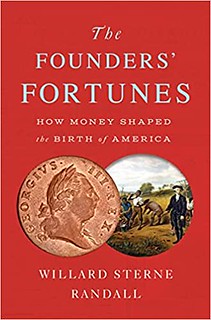 Historian Randall (Unshackling America) explores in this intriguing yet unsatisfying survey how the founding fathers' personal financial circumstances helped chart the course of the American Revolution. Delving into the business interests and economic considerations of George Washington, Benjamin Franklin, John Adams, Thomas Jefferson, and others, Randall notes that almost all of Connecticut's delegation to the Second Continental Congress in 1775 were land speculators, motivated in no small part by King George III's decree barring them from profiting from the fur trade. He also points out that the resistance movement in Massachusetts was bankrolled by John Hancock, whose merchant empire was threatened by English taxes, and that Benjamin Franklin, contrary to his
Historian Randall (Unshackling America) explores in this intriguing yet unsatisfying survey how the founding fathers' personal financial circumstances helped chart the course of the American Revolution. Delving into the business interests and economic considerations of George Washington, Benjamin Franklin, John Adams, Thomas Jefferson, and others, Randall notes that almost all of Connecticut's delegation to the Second Continental Congress in 1775 were land speculators, motivated in no small part by King George III's decree barring them from profiting from the fur trade. He also points out that the resistance movement in Massachusetts was bankrolled by John Hancock, whose merchant empire was threatened by English taxes, and that Benjamin Franklin, contrary to his Poor Richard
persona, became wealthy by investing the profits from his printing and publishing business in Philadelphia real estate.
Unfortunately, Randall downplays other political and cultural factors behind the revolution and risks oversimplifying the motivations and considerations of his subjects, as when he suggests that George Washington's diminished financial circumstances were behind his acceptance of the presidency and its annual salary of $25,000 ($750,000 in today's money). Readers will find Tom Shachtman's The Founding Fortunes to be a more thoughtful and nuanced treatment of the same subject.
For more information, or to order, see:
The Founders' Fortunes: How Money Shaped the Birth of America
(https://www.publishersweekly.com/978-1-524745-92-9)
The Founders' Fortunes
(https://www.penguinrandomhouse.com/books/617803/the-founders-fortunes-by-willard-sterne-randall/)
MARRIED WOMEN UNWELCOME AT THE MINT
The latest addition to the Newman Numismatic Portal is a letter from Mint Superintendent Snowden about a rule barring married women from working there. Project Coordinator Len Augsburger provided the following report. -Editor
Married Women Unwelcome at the Mint
While it is well-known that the U.S. Mint employed women as adjusters from its earliest days, it seems that this practice was limited to unmarried women only. An 1880 letter from Mrs. A. C. D. Lewis to the Philadelphia Mint Superintendent A. Louden Snowden notes that Lewis is resigning her adjuster position, as it is against the rules of the Mint for any woman to be employed there who is living with her husband.
Lewis notes that she had been warned accordingly and submits a forwarding address for any wages due up to the time of my marriage."
Link to July 9, 1880 letter from Lewis to Snowden:
https://nnp.wustl.edu/library/book/611680
Link to U.S. Mint general correspondence (National Archives record group 104, entry 1) on Newman Portal:
https://nnp.wustl.edu/library/archivedetail/515202
VIDEO: SPRING 2022 LONG BEACH EXPO
These are selections from the David Lisot Video Library that feature news and personalities from the world of coin collecting. David has been attending coin conventions since 1972 and began videotaping in 1985. The Newman Numismatic Portal now lists all David's videos on their website at:
https://nnp.wustl.edu/library/multimediadetail/522852
Here's one on the recent Long Beach show. -Editor
Long Beach Expo Features Something for Every Collector.
VIDEO: 5:15.
Heather Boyd, Marketing Director, Professional Coin Grading Service (PCGS),
David Lisot, Interviewer, CoinTelevision.com. February 17-19, 2022.
 The Long Beach Coin, Currency, Stamp & Sports Collectible Show is a collector's paradise. Join Heather Boyd, PCGS Marketing Director, as she takes you on a tour of the February 2022 Expo and shows and talks about the new banknote pack grading, PCGS Set Registry, WATA video game service and much more.
The Long Beach Coin, Currency, Stamp & Sports Collectible Show is a collector's paradise. Join Heather Boyd, PCGS Marketing Director, as she takes you on a tour of the February 2022 Expo and shows and talks about the new banknote pack grading, PCGS Set Registry, WATA video game service and much more.
David adds:
"It was my first trip to California in almost three years since the COVID Pandemic. The Long Beach Expo has been revitalized into a new hall with all new logos and much more contemporary surroundings. Crowds of people were waiting to get in the show on the first day to get their coins and collectibles graded and to buy, sell, trade coins, stamps, sports, and even video games. If you have waited to return to Long Beach you will not want to wait any longer."
An excerpt of the video is available for viewing on the Coin Television YouTube Channel at:
https://youtu.be/0hg-lPFSFk0
THE BOOK BAZARRE
AUDIO: ABBY ZECHMAN INTERVIEW
The Coin World Podcast recently featured an interview with Abby Zechman. Check it out. -Editor
The Coin World Podcast co-hosts interview Abigail Zechman, a hobo-nickel-carving Young Numismatist recently elected to the board of FUN and discuss, among other things, a 2018 issue of Coin World.
To listen, see:
Keys to Getting Involved — An Interview with Abby Zechman
(https://www.coinworld.com/news/us-coins/cwpod_ep153)
MORE NUMISMATICS IN TV AND MOVIES
Here are more reader notes on numismatics in film, television and on the stage. -Editor
Brad Karoleff writes:
"This weekend I was channel surfing and came upon a movie, "12 Mighty Orphans" about a 1930's orphanage football team in Texas. It is based on a true story and has a couple interesting numismatic connections!
"During the movie there are a few scenes featuring Treat Williams playing.....Amon Carter! In one of them he is betting on the football game and a $50 National Currency note is shown trading hands.
"Overall the movie is a little corny with the fake football scenes but it does convey the feelings of the time and, at the end, a review of the characters tells us about their life stories after graduating from the Masonic Orphanage school."
Fort Worth, Texas collector Amon Carter built a legendary collection including coins from the Dexter, Neil, Colonial Green, Atwater, Olson, Roe, Granberg, Newcomer, and Haseltine collections.
Another bigtime collector is in the news and being played on the screen. Yesterday I heard a review on National Public Radio of the new HBO series Winning Time about the Los Angeles Lakers. My ears perked up when I heard the name of the team's owner, Jerry Buss. Numismatists know Buss as a collector and owner of the the Idler specimen 1804 silver dollar and the Olsen specimen of the 1913 Liberty Head Nickel (the one that itself starred in an episode of "Hawaii Five-O"). -Editor
To read the review of Winning Time, see:
Like the '80s Lakers, 'Winning Time' scores with an unconventional playbook
(https://www.npr.org/2022/03/04/1084161115/winning-time-review-los-angeles-lakers-basketball)
Gil Parsons writes:
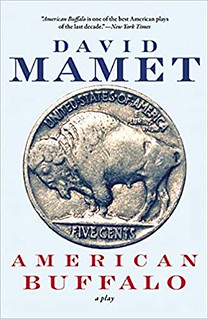 "One of the very best pieces with coins at the center is David Mamet's American Buffalo, perhaps ignored because the film from 1996 is actually BAD, with Dustin Hoffman in a bit of a throwaway performance. The play, however, from 1975, with Al Pacino in the central role is terrific, and the play ranks as an American classic of greed, deceit, and general lowlife with the characters contending over the acquisition of a Buffalo Nickel.
"One of the very best pieces with coins at the center is David Mamet's American Buffalo, perhaps ignored because the film from 1996 is actually BAD, with Dustin Hoffman in a bit of a throwaway performance. The play, however, from 1975, with Al Pacino in the central role is terrific, and the play ranks as an American classic of greed, deceit, and general lowlife with the characters contending over the acquisition of a Buffalo Nickel.
"I imagine there is a video record of the original Chicago production available somewhere: I was fortunate to see Pacino recreate his role in San Francisco--a magnificent evening of theatre!! While nothing can fully recreate the energy of the play on stage, even the book of the script is worth a look for the magnificence of Mamet's language and for the insight into what the dark side of numismatics might look like..."
Thanks, everyone. And here's a PCGS article by Joshua McMorrow-Hernandez on Buffalo nickels on television in the 1980s. -Editor
Interestingly, as I think back on Buffalo Nickels and their appearances on television during my childhood years, The Match Game certainly wasn't the only place one could catch a reference to these beloved five-cent coins. As a railroad-obsessed child of the 1980s (my playroom was filled with BRIO wooden railway sets and electric trains – some of which I still own), I used to enjoy watching the live-action PBS television show Shining Time Station. This series, originally running from 1989 through 1993 and starring former Beatles musician Ringo Starr, Grease actress Didi Conn, and – later in the series – comedian George Carlin, centers around the characters who live, work, and play at a quaint railroad station in smalltown U.S.A.
In this railroad station is a jukebox that plays music whenever one of the characters drops a nickel in, prompting live
music as created by a band of tiny musicians (Flexitoon puppets and marionettes) who play happy tunes. In one episode, as typical, a human character outside the jukebox decides to summon music by dropping a nickel in. But this time it wasn't just any old nickel... It was a Buffalo Nickel – much to the delight of one of the band members who immediately recognizes the vintage coin and waxes nostalgia about these relics that hearken to the romance of the Old West.
To read the complete article, see:
When The Buffalo Roamed TV Screens in the 1980s…
(https://www.pcgs.com/news/when-the-buffalo-roamed-tv-screens)
To read the earlier E-Sylum articles, see:
THE AMON G. CARTER, JR. FAMILY COLLECTION, PART 1
(https://www.coinbooks.org/esylum_v17n25a20.html)
GERALD "JERRY" BUSS 1934 -2013
(https://www.coinbooks.org/esylum_v16n08a06.html)
DENNIS THE MENACE NUMISMATICS
(https://www.coinbooks.org/v25/esylum_v25n09a14.html)
MORE TELEVISION AND MOVIE NUMISMATICS
(https://www.coinbooks.org/v25/esylum_v25n09a15.html)
MORE ON VERNON M. JEPSON
Julia Casey writes:
"I saw Jerome Nashorn's research on Vernon M. Jepson and the eBay listing for the First American Coin Collector medal. When I searched for Vernon Jepson in the newspaper databases I did not find mention of him collecting coins, but I learned he was a collector of gourds and stamps. Here are the stories."
The second was a story that was republished in many national newspapers. This image is from the Evansville Journal (Indiana) 10/28/1933. I note these stories came out after Vernon Jepson had died. Also that the text mistakenly refers to him as a Confederate veteran. I found a Pinterest link to this image and it credits the Osceola Historical Society with the description:
"Vernon Jepson, a native of Massachusetts was one of the Union Veterans who settled in St. Cloud, Florida. When Vernon, an avid stamp collector, discovered duplicates in his collection he decided to use them to paper a room in his house at 606 Wyoming Avenue, making intricate designs. Vernon died in 1932. Sources: St. Cloud Tribune February 28, 1958; OCHS Archives"
Thanks! Having seen countless examples of people tiling walls and floors with coins, it's refreshing to see someone had the same idea with stamps. -Editor
To read the earlier E-Sylum article, see:
NOTES FROM E-SYLUM READERS: FEBRUARY 27, 2022 : More on the First American Coin Collector Medal
(https://www.coinbooks.org/v25/esylum_v25n09a16.html)
NOTES FROM E-SYLUM READERS: MARCH 6, 2022
Reader Kudos
David Derrick writes:
"Thank you for continuing to post The E-Sylum. Great topics and great reading. Knowledge is everything, especially in numismatics and related."
You're welcome! It's always fun to put together. Something new every day. -Editor
More on Bookseller David Edmunds
Peter Preston-Morley of Dix Noonan Webb writes:
 "I did know David Edmunds quite well, not as well obviously as Douglas Saville, but our paths crossed frequently enough back in the 1970s when his catalogues of numismatic literature were issued quite frequently and I was an occasional purchaser from them. I still have a few early issues. I think our paths first crossed when the late Robert Thompson put me in touch with him a year or two after he published what is still the definitive article on the 19th century token issuer John Berkeley Monck, proprietor of one of only two private gold tokens in the British series. David was very interested in tokens and token literature, though whether he had his own collection or not I don't know. His short-lived association with Seaby Rare Books and the late Peter Jones coincided with, as Douglas mentioned, a downturn in the market."
"I did know David Edmunds quite well, not as well obviously as Douglas Saville, but our paths crossed frequently enough back in the 1970s when his catalogues of numismatic literature were issued quite frequently and I was an occasional purchaser from them. I still have a few early issues. I think our paths first crossed when the late Robert Thompson put me in touch with him a year or two after he published what is still the definitive article on the 19th century token issuer John Berkeley Monck, proprietor of one of only two private gold tokens in the British series. David was very interested in tokens and token literature, though whether he had his own collection or not I don't know. His short-lived association with Seaby Rare Books and the late Peter Jones coincided with, as Douglas mentioned, a downturn in the market."
"I was sad to hear of the passing of David Edmunds, a pioneer of the numismatic book trade in the UK, who had a fondness for British token literature. It may interest readers to know that he used an ink stamp with his initials to mark books from his personal library. I bought one, Waters 1906 work on Middlesex tokens, without knowing whose initials DRDE were. I was delighted to find out from Harold Welch that they were David's."
Thanks, everyone. I never had the opportunity to meet him, but he was a giant in the field of numismatic literature. -Editor
To read the earlier E-Sylum article, see:
DAVID R. DRURY EDMUNDS (1939-2022)
(https://www.coinbooks.org/v25/esylum_v25n09a08.html)
More on the 1922 High Relief Peace Dollars
A reader who watched Doug Ward's presentation on the high relief 1922 Peace dollars recommends reviewing Roger Burdette's Renaissance of American Coinage 1916-1921 for discussion and analysis of the differences in design between 1921, 1922 HR, 1922 MR and how they left the Philadelphia Mint. -Editor
To read the earlier E-Sylum article, see:
NOTES FROM E-SYLUM READERS: FEBRUARY 27, 2022 : 1922 High Relief Proof Peace Dollar Presentation
(https://www.coinbooks.org/v25/esylum_v25n09a16.html)
ANCIENT COINS WITH KENNETH BRESSETT
As noted last week, hobby legend Ken Bressett, author and Red Book Editor Emeritus will be at the ANA National Money Show in Colorado Springs, March 10–12, 2022. Here's a note from Whitman Publications on his latest book. -Editor
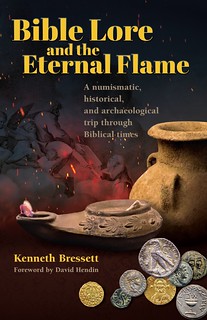 Kenneth Bressett will autograph his new book Bible Lore and the Eternal Flame at the
American Numismatic Association's National Money Show in Colorado Springs, March 10,
2022. After that debut the 224-page hardcover volume will be available from bookstores
and hobby shops and online (including at Whitman.com). Here, Whitman publisher Dennis
Tucker discusses how the book came to be, its context among other numismatic
publications, and how it was developed.
Kenneth Bressett will autograph his new book Bible Lore and the Eternal Flame at the
American Numismatic Association's National Money Show in Colorado Springs, March 10,
2022. After that debut the 224-page hardcover volume will be available from bookstores
and hobby shops and online (including at Whitman.com). Here, Whitman publisher Dennis
Tucker discusses how the book came to be, its context among other numismatic
publications, and how it was developed.
In February 2021, Kenneth Bressett's latest manuscript, A Penny Saved: R.S. Yeoman and His Remarkable Red Book, was well into production. (The book would debut that August at the American Numismatic Association World's Fair of Money.) In the midst of that ongoing work, I mailed Ken an article that had caught my eye in the current issue of Biblical Archaeology Review. It was about specific uses of ancient pottery in the Holy Land. Years earlier Ken had shown me some Greek and Roman amphorae and coins from his personal collection, and I knew he'd find the article interesting.
A few days later he replied. This subject is especially timely because lately I've been thinking
about writing a sequel to my book Money of the Bible, and have been doing some research on
related topics. I would appreciate your thoughts on this, and if you think it is worth pursuing....
As any publisher would be, I was delighted by this proposal. And having been Ken's publisher for more than fifteen years, I wasn't at all surprised that he was thinking ahead to his next project—even before the ink was dry on his latest book!
The resulting work, Bible Lore and the Eternal Flame, is not Whitman Publishing's first in the
field of ancient coins. Recent publications include Coins of the Bible (Friedberg, 2004), a
popular exploration of the subject.
Continuing Bressett's Long Interest in the Ancients
Like Whitman, Ken Bressett is not a newcomer to the ancient world. Although he's popularly
known as the editor (and, now, editor emeritus) of the Guide Book of United States Coins and
has been involved in many aspects of modern American coinage, Ken has a long-held passion for
ancient coins. In addition to pursuing his own research, starting in the 1960s Ken encouraged
Zander H. Klawans to contribute articles on ancient coins to the Whitman Numismatic Journal.
In 1994 he crafted a new work from two of Klawans's well-established books (Reading and Dating Roman Imperial Coins and An Outline of Ancient Greek Coins). He skillfully edited them
into a single volume to aid both beginning and advanced students. The resulting Handbook of
Ancient Greek and Roman Coins has since been a constant reference for collectors, with tens of
thousands of copies in print.
More recently, Ken's Money of the Bible, first published in 2005, has similarly proven to have evergreen appeal. It was updated in new editions in 2007 and 2013.
Another Bressett opus, Milestone Coins: A Pageant of the World's Most Significant and Popular Money (2007), featured chapters on the ancient world and Biblical money.
The association of coins with past events is widely known and appreciated by archeologists and
historians, but it is often overlooked by Bible students,
Ken wrote in the introduction to Money
of the Bible. As did that book, Bible Lore and the Eternal Flame seeks to investigate the money
of the ancient world as a means of exploring the Old and New Testaments, and to bring students
closer to understanding, and appreciating, the historical context of biblical stories.
What the Book is Not
Bible Lore and the Eternal Flame is not a price guide, a market study, or a how-to handbook for
collectors. What it offers students is that special magic of new light shone on enduring subjects;
the clarity of obscure connections brought into sharp focus; and the pleasure of tales well told.
These all are sparks that can lead to collecting. Or they may additionally inform and enrich the
understanding of the historian, archaeologist, and student of theology or the ancient world.
A Multifaceted Approach
Bressett was careful to research Bible Lore and the Eternal Flame from many disciplines and
perspectives. He even sought the review of skeptics and non-believers, whose perceptions were
given special consideration in parts of the manuscript. I want to present a picture of how
numismatics and archeology help in establishing a clearer image of ancient times,
he told me in
one conversation about the book.
On the other side of the coin, it was important for Ken to seek the imprimatur of the Roman Catholic Church. After a careful review of the manuscript in accord with canon 827 of the Code of Canon Law, Nihil Obstat was issued and the Bishop of Colorado Springs granted the Church's imprimatur.
Like a Personal Visit With Ken Bressett Himself
Many of the coins pictured in Bible Lore and the Eternal Flame are from Ken Bressett's personal
collection. Reading his new book is nearly the equivalent of sitting down with one of the world's
best numismatic storytellers and doing something Ken himself is always up to: learning,
learning, learning, and enjoying every minute of it.
Bible Lore and the Eternal Flame.
By Kenneth Bressett; foreword by David Hendin.
ISBN 0794849768. Hardcover, 6 x 9 inches, 224 pages, full color.
Retail $24.95 U.S.
https://whitman.com/bible-lore-and-the-eternal-flame/
To read earlier E-Sylum articles, see:
NEW BOOK: BIBLE LORE AND THE ETERNAL FLAME
(https://www.coinbooks.org/v25/esylum_v25n05a03.html)
KEN BRESSETT AT 2022 NATIONAL MONEY SHOW
(https://www.coinbooks.org/v25/esylum_v25n09a04.html)
2022 NATIONAL MONEY SHOW EXHIBITS AND TALKS
There are a number of eductional opportunities awaiting visitors to the ANA National Money Show in Colorado Springs, CO March 10-12, 2022. -Editor
"The Medal in America" Museum Exhibit
During the 2022 National Money Show, "The Medal in America" exhibit will debut at the ANA's Edward C. Rochette Money Museum. A member reception on Thursday, March 10 is scheduled from 6-7:30 p.m. to unveil the exhibit at ANA headquarters."This important new exhibit will feature medals that trace the history of the United States from colonial times to the present, starting with the invention of modern medals and how they are made," explains Doug Mudd, Money Museum curator and director.
The exhibit will include an impressive display of George Washington-related medals from the Historical Society of Pennsylvania's famous Baker Collection, recently donated to the museum by ANA benefactor Dwight Manley.
Collector Exhibits
Learn from fellow collectors who share their knowledge, research, creativity and collections with their own exhibits. There are educational displays on every area of numismatics from ancient coins and artifacts, tokens and medals, world coins, to modern United States coins and paper money. This year's exhibits include –
- Colonial Colorado's Silver Reals 1536-1821
- 1904: Give Me One Penny... You Get a Nice Souvenir
- U.S. Postal Notes of 1883 to 1894 the Little-Known Offspring of Fractional Currency
- Shining Lights in an Age of Darkness
- Great Art in the Palm of Your Hand
- Meteorite Coins
- A Type Set of Dutch-Israel Gold Fantasy Coins
- Israel's Coin Designs: Ancient Masterpieces and Modern Inflation
- The Roaring Lion of Megiddo
- The Heh Amulet
- Engraved Coins of the "Three Abrahamic Faiths"
- Western & Atlantic Railroad
- Wartime Change: Alterations in U.S. Coin Metal Content During World War II
- One Hundred Plus – The Colorado Springs Centennial Medal
- Making the Grade – the 1900-O Morgan Dollar Grading Set
- Tokens from Three El Paso Saloons Connected to the Last Days of John Wesley Hardin: Desperado, Killer and Attorney
- The Big 4: Examples of the National Banknotes of Colorado Springs
- Man, Machine & Medal: An Inventor's Success at the 1915 Panama-Pacific International Exposition
- Numismatic Mementos of the Little Tramp
- Smith of Ann St. and His "Counterfeits"
- Boar Hunt!
- Post WWI Hyperinflationary Currency of Germany
Learn more about what to expect and read full descriptions of these collector exhibits by visiting money.org/nationalmoneyshow/exhibit-descriptions.
Money Talks Presentations
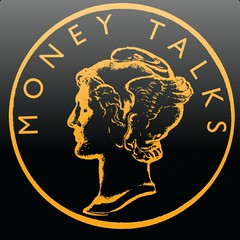 Money Talks provide members a forum in which to share their views and research with fellow hobbyists. The numismatic lectures are presented each year at ANA conventions and are free to attend. Presentations are 30- to 45-minutes each, including questions from the audience.
Money Talks provide members a forum in which to share their views and research with fellow hobbyists. The numismatic lectures are presented each year at ANA conventions and are free to attend. Presentations are 30- to 45-minutes each, including questions from the audience.
This year's presentations are Thursday, March 10 and Friday, March 11 from 10 a.m. to 3 p.m., with an intermission at noon.
To read the schedule of Money Talks presentations, see:
Let's Talk About It
(https://f.hubspotusercontent30.net/hubfs/6180285/
2022%20National%20Money%20Show%C2%AE%20Schedule.pdf)
CONFERENCE: NETWORKS IN TRANSITION
A conference organized by Princeton's FLAME project is coming up later this month. NOTE - it is both in-person and virtual, so interested parties can attend via Zoom. -Editor
Title:
Networks in Transition: Monetary Exchange from Antiquity to the Middle Ages
When/Where:
March 18th, 12:30pm–5:45pm (East Pyne 010)
March 19th, 8:30am–5:00pm (East Pyne 010)
March 20th, 9:00am–1:00pm(Firestone C10H)
Description:
 This conference will bring together an international group of scholars who have worked on Princeton's FLAME project, as well as leading scholars on the late antique and early medieval economy worldwide (4th-8th centuries CE). Over three days, speakers will present new findings centered on the research priorities of the FLAME project. Participants will share insights on economic, political, and social changes throughout this period, but will also reflect upon the historiographical and methodological problems posed by the project itself. An exhibition of coins relating to the conference from the Princeton University Numismatic Collection will accompany the conference and will be on display outside of East Pyne 010 on March 18th and 19th.
This conference will bring together an international group of scholars who have worked on Princeton's FLAME project, as well as leading scholars on the late antique and early medieval economy worldwide (4th-8th centuries CE). Over three days, speakers will present new findings centered on the research priorities of the FLAME project. Participants will share insights on economic, political, and social changes throughout this period, but will also reflect upon the historiographical and methodological problems posed by the project itself. An exhibition of coins relating to the conference from the Princeton University Numismatic Collection will accompany the conference and will be on display outside of East Pyne 010 on March 18th and 19th.
The events will occur in-person on Princeton University campus, as well as virtually, by Zoom.
Keynote Speakers:
Rory Naismith, University of Cambridge
Florin Curta, University of Florida
Khodadad Rezakhani, University of Leiden
Stephan Heidemann, University of Hamburg
How to register:
The event is open to the Princeton community as well as to the public. Registration is required for on-campus attendees, as well as those attending virtually. To do so, please visit:
https://libcal.princeton.edu/event/8875023
CENTRAL STATES U.S. RARITIES DISPLAY
GreatCollections is sponsoring a display of U.S. rarities at the upcoming Central States show. Here's the announcement. -Editor
Four of the most famous United States rare coins with a combined face value of only $1.16 but insured now for $19 million will be displayed together for the first time at the Central States Numismatic Society convention in the Chicago suburb of Schaumburg, Illinois, April 28-30, 2022.
One of the four great rarities in the upcoming special display is the finest 1804 Draped Bust dollar, the Sultan of Muscat example that has rarely been seen since 1998. The three other coins in the exhibit will be the Eliasberg 1913 Liberty Head nickel, the Eliasberg 1894-S Barber dime, and a 1943 bronze Lincoln cent wrong planchet error
This incredible display is being arranged by Ian Russell, president of GreatCollections Coin Auctions (www.GreatCollections.com),
said Larry Shepherd, CSNS convention manager.
The GreatCollections exhibit will be a highlight of our convention, and it will last in collectors' memories for years. I know, because I had the thrill of viewing the 1804 Sultan of Muscat dollar with Dave Bowers and bidding on it when he brought it to auction in 1999. The 1913 Liberty Head nickel was in my hands during lot viewing for the 1996 Eliasberg auction. Despite the many years that have passed, I can't forget the thrill of seeing these marvelous rarities in person. Both instances are among the highlight memories of my numismatic life,
stated Shepherd.
I acquired these ‘Big 4' coins over the past year on behalf of clients who are now loaning these extraordinary numismatic treasures so they can be together for the first time in public,
explained Russell.
The fabled Class I Original 1804 dollar was presented as a diplomatic gift by U.S. State Department representative Edmund Roberts to the Sultan of Muscat (the capital of Oman) on behalf of President Andrew Jackson in 1835. Graded PCGS PR68 and the finest 1804 dollar, it previously was in the collection of Texas real estate developer D. Brent Pogue.
The 1894-S dime is graded PCGS PR65+ and one of the finest of only nine known examples from the 24 struck that year at the San Francisco Mint. This coin was part of a Bicentennial exhibit in 1976 when it in the legendary collection of Baltimore financier Louis E. Eliasberg, Sr. It recently was acquired by Russell from noted Las Vegas collector Bruce Morelan.
The Eliasberg 1913 Liberty Head nickel is one of the most famous and coveted rarities in American numismatics with only five examples known. Graded PCGS PR66 CAC and the finest of the five, it also was recently acquired by Russell from Morelan. It is one of only three examples in private hands. The other two 1913 Liberty Head nickels are in the National Numismatic Collection at the Smithsonian National Museum of American History and the American Numismatic Association Edward C. Rochette Money Museum.
The 1943 bronze cent is graded PCGS AU58 CAC and previously was in the extensive collection of Texas Rangers baseball team Co-Chairman Bob R. Simpson.
We thank Ian Russell, GreatCollections, and the owners of these historically significant coins for honoring Central States with this display and giving visiting collectors and dealers a once-in-a-lifetime opportunity to see them together,
stated Shepherd.
Visitors to the 2022 Central States Numismatic Society convention will find an expanded bourse area with more U.S. and world coin and banknote dealers and more exhibits. A limited number of dealer tables are still available, according to CSNS convention organizers.
Official auctions will be conducted by both Heritage Auctions (www.HA.com) and Legend Rare Coin Auctions (www.LegendAuctions.com) in conjunction with the convention.
Professional Coin Grading Service (www.PCGS.com) is the Official Grading Service for the Central States Numismatic Society. CSNS also is the home show for the Professional Currency Dealers Association (www.PCDAonline.com). The Professional Numismatists Guild (www.PNGdealers.org) will conduct a PNG Day on April 27.
The April 27-30, 2022 CSNS show will be at the Renaissance Hotel and Convention Center, 1551 Thoreau Dr., in the Chicago suburb of Schaumburg, Illinois. That state-of-art convention facility and hotel, located only 13 miles from O'Hare International Airport, have been the site of CSNS conventions in recent years.
For more information, see:
https://www.centralstatesnumismaticsociety.org/convention
THE BOOK BAZARRE
VOCABULARY TERM: HUB, HOB
Here's another entry from Dick Johnson's Encyclopedia of Coin and Medal Terminology. -Editor
Hub, Hob. A die of positive relief used for making a working die or dies. Hubs are always the opposite relief of the striking die. They are a method of reproducing or trans- ferring a three-dimensional image from one hard surface into another. As such, hubs and hubbing are a method of producing working dies in quantity for long production runs, or an insurance that a new die can be easily made should any working die break. Hubs can be the entire design of one side of a coin or medal, or it can also be a portion of the design – as a portrait or device – and as such is similar to a puncheon.
In diemaking, it is essential to understand a number of similar terms that are closely related to hubs. It thusly becomes necessary to understand these in the numismatic field as well. (Each of these terms has its own entry in this encyclopedia for further detail):
Master Die – A die from which other dies or hubs may be made (it can be either positive or negative).
Patrix – A hub; that from which a matrix is made; it is always positive with convex or raised relief similar to the final struck piece.
Matrix – A die for use in striking; it is always negative with concave or incised relief.
Transfer Die – An intermediate die, copying relief design to be sunk into a working die as a later step.
Punch, Puncheon – A portion of the total design from a simple letter to the entire device in raised or positive relief.
Cameo Die – A die cut or carved in the positive from which working dies would be made (by two steps of hubbing).
Portrait Die – Die bearing a portrait – usually positive – to be sunk into a working die with lettering and ornamentation (if any) to be added later.
Reduction Punch – A punch cut on a die-engraving pantograph of a portion of the total design, usually the device alone.
Hubs are made in any of several ways: they can be hand engraved (working in the positive, as a cameo die), they can be pantographically cut (from a positive hub shell), or they can be hubbed from any negative die (as a master die).
Hubs are always positive and look like the ultimate piece they are intended to reproduce. The first use of the term, in 1851, was hob (rhymes with rob) and for the most part this is the term still in use in Great Britain. Americans, however, have come to prefer hub (rhymes with rub) and hubbing (both in spelling and pronunciation) although some oldtimers still use the earlier form, hobbing. (Hob and hobbing is the name of the process for cutting worm gears in gear manufacturing so perhaps it is useful to reserve hub and hubbing for diesinking.)
The purpose of any hub is to create a striking or working die and this is always done by hubbing (see next entry). There is only one item in which the hub would be used for striking, to create a signet medal (which would have negative relief to form positive sealing wax impressions).
To read the complete entry on the Newman Numismatic Portal, see:
Hub, Hob
(https://nnp.wustl.edu/library/dictionarydetail/516069)
FRANCIS CARLOS HIGGINS (1867-1928)
American Numismatic Biographies author Pete Smith submitted this article on American Numismatic Association personality Frank C. Higgins. Thanks! -Editor
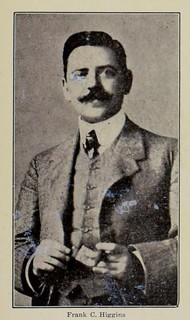 If events had played out a little differently, Frank C. Higgins might be in the ANA Hall of Fame.
If events had played out a little differently, Frank C. Higgins might be in the ANA Hall of Fame.
Francis Carlos Higgins, more commonly known as Frank C. Higgins, was born in Philadelphia on January 7, 1867. His parents were Paul Lajus Higgins (1842-1926) and Clarissa Enos (1840-1921). They were divorced and both remarried.
At the time of the 1880 Census, Frank was living in Germantown, Pennsylvania, with his mother and employed as an office clerk at age 13. He attended Shattuck Military Academy at Faribault in Minnesota.
He began newspaper work with the Philadelphia Public Ledger. Later he was a reporter for the St. Paul Dispatch and Minneapolis Tribune. He was sent to Paris in 1889 as a special correspondent for the New York Press and Boston Daily Globe. In 1896 he became press representative for Non-Flammable Wood Co. Ltd, a company affiliated with Edward, the Prince of Wales. In 1897 he went on a special mission to Alfred, the Duke of Saxe-Coberg and Gotha, the second son of Queen Victoria. In 1898 he applied for a passport giving his address as St. Paul, Minnesota, and his occupation as journalist.
While in Europe in 1892, Higgins wrote Introduction to Modern Copper Coins of Europe. He later reported that copper coins frequently are high priced in their country of origin but cheap in other countries.
Higgins was a Fellow of the Royal Numismatic Society in England. When he applied for ANA membership in 1902, he was living in London. In the July, 1902 issue of The Numismatist he reported on various dealers he had encountered while living and travelling through Europe. In 1908 he had an address change to New York.
In the November 1908 issue of The Numismatist, he proposed formation of a local club in New York City. This developed into the New York Numismatic Club with Higgins as the first president. In 1909 he was the district secretary for the ANA.
Also in 1909 he was listed as one of three associate editors of The Numismatist and praised in an editorial. The listing said, Frank C. Higgins, Linguist, Foreign Editor.
He was listed through the June 1909 issue but his name was removed for the July 1909 issue.
The July 1909 issue of The Numismatist noted nominations for officers to be elected at the Montreal convention in 1910. Candidates for president were Frank C. Higgins and Dr. J. M. Henderson. Thus began a highly contentious campaign conducted primarily by surrogates. New York dealer Thomas Elder supported Higgins while outgoing president Farran Zerbe supported Henderson.
An article by Douglas Ward in the Spring 2022 issue of The Asylum has an excellent discussion of the election, The American Numismatic Association Election of 1909 as Viewed through its Membership Applications from 1907 to 1910.
Zerbe and Henderson conducted the more effective campaign and Higgins conceded the election. Eventually Henderson made it into the ANA Hall of Fame. After the election, Higgins faded from active participation in numismatics. He put his efforts into books on the Masonic Fraternity.
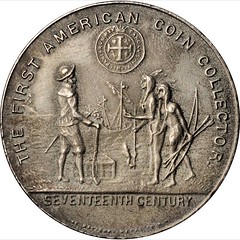 Higgins designed the
Higgins designed the First American Coin Collector
medal issued in January 1911. He designed other medals produced for Thomas Elder including the Hendrick Hudson Daalder (DeLorey 74), the Robert Fulton / Clarmont piece (DeLorey 76) and the Irish Crown (DeLorey 78).
Higgins proposed a series of dollar sized medals he called Family Dollars
which would honor the legacy of an American family. The first was issued for the Evans family. His scheme was not successful and is unrelated to a Family Dollar store that may be in your neighborhood.
During World War I, he was civilian yard master at the United States Engineer Depot at Kearny, New Jersey. His language skills got him transferred to the United States Department of State. The 1920 Census gives his profession as U. S. government inspector.
Tracking his marriages and children was a challenge and records may be incomplete. It appears that Frank was married four times. His first marriage was to Virginia Catherine Freyburger (1865), born in Paris. Their son was Maurice Eugene Higgins, born August 30, 1888, in Manhattan.
His second marriage was to Clara Elizabeth Brailey (1872) in 1893 in London and ended in divorce in 1900. They had a son, Frank E. Higgins, born in 1898.
His third marriage was to Marie Louis Jeanne Gillot (1880-1944), who was born in Paris, on September 16, 1903, at St George, Hanover Square, London, England. Their children were Francis Lynch (Born in London, 1905-1980), Marie Pauline Lajus (Born in London, 1907) and Louis Eugene (Born in New York, 1912-1970).
His fourth marriage was to Flora MacDonald McClure (1890-1973) on October 20, 1928, at Cheektowaga, New York, shortly before his death.
Higgins was a 32nd degree Scottish Rite Mason and Past Master of Ivanhoe Lodge 610 in New York City. He died in Manhattan on December 10, 1928, and is buried at Woodlawn Cemetery in Bronx, New York.
Thanks. Pete! Excellent bio of an important numismatic figure. The images are from Mehl's Numismatic Monthly. -Editor
To read the earlier E-Sylum articles, see:
THE FIRST AMERICAN COIN COLLECTOR MEDAL
(https://www.coinbooks.org/v25/esylum_v25n08a14.html)
NOTES FROM E-SYLUM READERS: FEBRUARY 27, 2022 : More on the First American Coin Collector Medal
(https://www.coinbooks.org/v25/esylum_v25n09a16.html)
HARVEY STACK'S NUMISMATIC FAMILY, PART 116
Stack's Bowers has a backlog of Harvey Stack's numismatic memoir articles and will continue publishing them. In this one Harvey discusses the year 1994 and the noncirculating issues of the U.S. Mint. -Editor
The year 1994 continued the upward trend in numismatics that had begun with the recovery from the Black Monday stock market "crash" of November 1987. This recovery was helped by the fact that the precious metals markets held their value, so coins that contained gold and silver may have lost a little value, but in general were considered a "good hold." During times when the stock market was way down, coins made of precious metals were considered by many to be a store of value and a better source for investment.
In addition, collectors who had the means used this time as an opportunity to add to their collections while prices were down slightly, and so continued to be good clients both through our auctions and in our retail sales. Many important collections were created and developed during this period. Buying and selling of coins among dealers also became a good business.
One ongoing issue was the large-scale production and sale of commemorative and other coins by the Mint, specifically geared toward collectors and investors, and marketed as an "investment in the future." Over its history, the Mint had always produced a certain number of coins specifically for collectors, most notably Proof coins and Proof sets and commemorative coins of the classic series from 1892 through the mid 20th century. In general, these collectible programs were good for the hobby, appealing to a certain type of collector and attracting new people to numismatics. They also tended to be sold at prices that were not much over the face value of the pieces, at least by the Mint.
In addition, certain "regular issue" coins also provided this outcome, whether intentional or not. I have seen it written that the change to the Barber coin design in 1892 for the dime, quarter and half dollar was a way to attract attention from the public. The Liberty Seated design had been in circulation for more than half a century and there was very little interest from those who collected from change. The coins with their new "look" were saved as a novelty and many ended up in piggy banks, kitchen jars, and dresser drawers. Of course, any new design made the coins that had been made before more interesting, as they were seen less and less in commerce.
A well-known example of a new coin issue leading to increased collector interest happened in 1883 when the Liberty Head nickel was first issued, a change from the Shield design which had been minted since 1866. The initial design for the 1883 nickel had just the letter "V" on the back to state the denomination, with no reference to what that "5" stood for. Millions of these nickels were made and released into circulation. Some of these were expertly plated with gold and passed off as $5 half eagle coins to unsuspecting businesses and the public. The Mint tried to withdraw all from circulation, but they were mostly unsuccessful. They then added the word CENTS under the V on the reverse and issued another 16 million coins. Although there were millions of the "CENT-less" nickels out there, the public thought that they would be rare and valuable. That did not end up being the case, but this turn of events led many to join the ranks of coin collectors.
In general, new designs nearly always stimulated increased interest, whether it was the advent of the Morgan dollar, the new designs of the early 20th century (including the fabulous new gold $10 and $20 designs by Augustus Saint-Gaudens), and even the Bicentennial designs of 1976 and the state quarters released beginning in 1999 (much more about this in a later article). As a rule, this was always a positive thing for numismatics.
However, by 1994 the Mint was creating more and more "non-circulating" coins for sale specifically to collectors and investors -- larger numbers of designs and denominations and larger mintages. Even with attracting new purchasers using extensive marketing campaigns, there was not enough interest to maintain prices for so many items and the constant striking and offering of new designs, special issues, special sets, bullion related medals and tokens to be sold at large premiums flooded the market. Those who bought these "investments in the future," especially if they were not long time collectors, were often disappointed when they went to cash in on their investment. As noted earlier, we at Stack's often had people come in the shop or contact us to sell or appraise these items and had to be the bearer of bad news about how the current value was lower, not only of what they had expected, but often lower than what they had paid. It was evident to us that the Mint's pricing and selling practices were excessive and were having a negative effect on the hobby and discouraging people from collecting.
It seemed to me that the Mint was not concerned with the buyers of their products or if those buyers lost money and also was not concerned about the growth of coin collecting as a hobby. It has always been my hope that in the future the Mint will start to make interesting coins for general circulation by commemorating important historical facts and get them out to the Federal Reserve Banks for general "change distribution." In this way the public could learn a bit of history from the different coins and appreciate each coin as an important part of economic life. All could realize that the Mint's job is to provide a medium of exchange to bolster and maintain our daily economy and be less concerned with how much profit can be made when the products are sold.
Meanwhile at Stack's we continued to use our decades of experience working with collectors of all levels to appraise, buy and sell the numismatic items that came our way. Whether it was a large, curated collection, a specialized hoard of items, or coins that ended up in a cookie jar or dresser drawer, we did our best to stimulate the hobby and provide a positive experience for everyone. Our role was to provide service to those entering the hobby, to those in the process of building collections small and large, and to those who were ready to sell, whether a part of their holdings or the entire cabinet. We also adapted to changing times as many of the people we served became more dependent on grading services and use of the Internet. These factors brought growth to numismatics and we saw more and more visitors to the shop, increased participation in our auctions, and greater attendance at conventions and coin shows. It was a very exciting time, and resulted in a strong year of auction presentations, which I will discuss in my next article.
To read the complete article, see:
Growing up in a Numismatic Family: Part 116
(https://www.stacksbowers.com/News/Pages/Blogs.aspx?ArticleID=growing-up-in-a-numismatic-family-part-116)
To read the earlier E-Sylum article, see:
HARVEY STACK'S NUMISMATIC FAMILY, PART 115
(https://www.coinbooks.org/v25/esylum_v25n08a15.html)
DON EVERHART'S CAREER IN COINS, PART 6
With permission, we're republishing excerpts of former U.S. Mint Sculptor-Engraver Don Everhart series published by CoinWeek beginning in April 2018. -Editor
In 2015 I began working on designs for the March of Dimes Commemorative Silver Dollar program. In this case, as in most commemoratives the mint produces, a percentage of the profits the mint makes on the coin would be given back to the recipient, the March of Dimes.
The obverse design that was ultimately chosen featured a well-executed double portrait of Franklin Roosevelt and Jonas Salk, who developed a vaccine to fight polio. Designed by Artistic Infusion Program artist Paul Balan and beautifully sculpted by staff engraver Mike Gaudioso.
One morning I was at my work station at the United States Mint feeling quite frustrated that I couldn't think of a worthy reverse design. I was wracking my brain trying to come up with something simple and iconic that conveyed the mindset and purpose of the March of Dimes organization – a design that they would be proud to put on their commemorative coin.
So far, zilch.
Then it hit me.
My daughter Cristina is a professional photographer in Pennsylvania and lives with her husband Jon and two young boys, Tyler and Jack. She does a lot of weddings and children's photography. More importantly, she has that rare ability to get the most out of her subjects, even crying babies.

Don Everhart working on the March of Dimes commemorative dollar coin plaster. Images: United States Mint / Everhart family (Facebook).
In June of 2012 (on her birthday), she was in the hospital giving birth to her second son (Jack). A little while after the child was born, her husband Jon was in the room with her holding the little newborn Jack in his hand.
Given the dedicated photographer she is, she had come equipped with her camera. Later in the day, in the hospital room she took a picture of the father holding his newborn son. The boy was small enough to be held in one hand. This photo flashed into my mind and I immediately felt it would be a powerful and most appropriate subject for the reverse design on the coin. It conveyed the total dependence of a newborn on his parents, and society in general. It totally fulfilled and illustrated the purpose of the March of Dimes organization. Additionally, it made a very nice design.
I called her and asked if she would mind if I used it for the basis of my coin design. She immediately gave her hearty consent and I began adapting the photo to my design.
I didn't use it verbatim. I changed several things; most notably the hand position and the hair and eyes. I also labored over the font and text placement. Cristina and the Mint signed off on the release of the photo and I submitted it to be considered for the reverse.
Ultimately the design was chosen and I thought about what a family effort it was to bring this design to creation. We had Jon, the father, holding his son, Jack, while the boy's mother Cristina took the photo that the grandfather (yours truly) worked into a design for an official national commemorative coin!
Who said I wouldn't enjoy working for the United States Mint?
To read the complete original article, see:
Don Everhart: My Career in Coins, Part 2 – The United States Mint
(https://coinweek.com/editors-choice/don-everhart-career-in-coins-part-2-the-united-states-mint/)
To read the earlier E-Sylum article, see:
Don Everhart's Career in Coins, Part 5
(https://www.coinbooks.org/v25/esylum_v25n09a24.html)
ATLAS NUMISMATICS MARCH 2022 SELECTIONS
Atlas Numismatics has updated their website with 542 new coins, medals, and tokens at fixed prices. Here's the press release. Some gorgeous pieces here. -Editor
Choice Mint State Bohemia 10 Ducats
1065627 | BOHEMIA. Ferdinand II. 1636 (p) AV 10 Ducats. NGC MS63. Prague. 34.63gm. Standing figure of Ferdinand II between two shields / Crowned imperial eagle. KM 319; Fr.-38; Dietiker 763; Halacka 713; Horsky-Unl.; Donebauer 2125 (RR).
Lustrous choice mint state and sharply struck; extremely rare as such. $165,000
To read the complete item description, see:
https://atlasnumismatics.com/1065627/
Agricultural Exhibition in Cairo Medal
1066688 | EGYPT. Farouk. (King, 1937-1952). (c. AH1356-1937) ND AR Medal. PCGS SP63. By Spink & Son. Edge: Incuse Arabic inscription. 45mm. 39.72gm. Crowned arms between two lions over an engraved inscription; all within branches / Nile landscape and the great pyramids of the Giza plateau in the background.
Struck for the agricultural exhibition in Cairo. $2,950
To read the complete item description, see:
https://atlasnumismatics.com/1066688/
Gem "Madonna" Thaler
1066307 | GERMAN STATES. Bavaria. Ludwig II. (King, 1864-1886). 1867 AR Thaler. PCGS MS66. By Carl Friedrich Voigt. Edge: XXX * EIN * PFUND * FEIN * - *. LVDOVICVS II BAVARIAE REX. Head, right; no part in hair / PATRONA BAVARIAE. Madonna with child, J. Reis below truncation. KM 877 (Prev. KM 494.1); Dav.-611; A.K.S.-176; J.-107; Kahnt 131. $1,350
To read the complete item description, see:
https://atlasnumismatics.com/1066307/
Prooflike Hamburg Portugalöser
1066604 | GERMAN STATES. Hamburg. 1677 HL AV 10 Ducats Medal (Bankportugalöser). NGC MS63+PL (Prooflike). By J. Rethe (or his son J. Reteke). 48.8mm. 34.80gm. QUATTUOR HIS SIGNIS PYRAMIS AUCTA DOCET// + HAMBURG +. Allegorical figure of abundance with cornucopia in her right hand and a scepter in her left hand; beside her fabric bales, crates and barrels on the ground, on a chest the initials PBM (Peter Burmester, the oldest bank citizen), on a barrel the signature IUR. To the right, a column inscribed with the coat of arms of the four banking cities. A city view in the background, and the radiant name of Jehovah, above / QUID PRUDENS CONCORS VIGILANS SOLLERTIA PRÆSTET. Three allegorical figures of wisdom, unity and vigilance standing with their attributes; radiant icon of the Trinity, above and a cartouche with date in Roman numerals, MDCLXXVII, below. Gaedechens III, 1609.
Commemorating the major European banking cities: Amsterdam, Hamburg, Nürnberg and Venice. Superb and exceptional with deeply prooflike surfaces. Very rare in all grades and extremely rare in this quality. $195,000
To read the complete item description, see:
https://atlasnumismatics.com/1066604/
Superb Goetz Medal Rarity
1066609 | GERMANY - EMPIRE. (1909) ND AR Medal. PCGS SP66+. By Karl Goetz. 60mm. 119.93gm. Facing half-length portrait wearing wig divides dates, 1653 - 1709 / Angel within inscribed ribbon and holding the helmeted family shield of arms. Kienast 125.
On the 200th Anniversary of the death of the Nuremberg patrician Johann Karl Schüsselfelder von Kirchensittenbach. Very rare in Silver. $6,750
To read the complete item description, see:
https://atlasnumismatics.com/1066609/
Sharply Struck Edward IV Angel
1066647 | GREAT BRITAIN. England. Edward IV. (King, 1461-1470 & 1471-1483). (1477-80)-(Pierced cross and pellet, #19) AV Angel. NGC MS64. London. 5.17gm. EDVVARDx DEI GRA'x REXx ANGLx Zx FRANCxx. St. Michael slaying the dragon with spear / PERx CRVCE'x TVAx SALVAx NOSx XPCx REDEM. Ship at sea with an "?" to right and a (rose) to left sides of masthead, all within beaded ring. SCBC-2091; North 1626.
Issued during Edward IV's second reign. Sharply struck and superb. $29,500
To read the complete item description, see:
https://atlasnumismatics.com/1066647/
Extremely Rare Proof or Pattern Victoria Two Pounds with No Designer's Initials
1066685 | GREAT BRITAIN. Victoria. (Queen, 1837-1901). 1887 AV Proof or Pattern Two Pounds. NGC PR64UCAM (Ultra Cameo). London. VICTORIA D:G: BRITT: REG: F:D:. Bust left wearing small crown and veil / St. George slaying the dragon. KM 768; SCBC-3865; W&R 291; Fr.-391a.
Jubilee head "Pattern" Two Pounds without B.P. in exergue. Newly published research
by David Iverson entitled 1887 Jubilee Head Two-Pound Pieces of Queen Victoria, A
comprehensive Study
has identified the importance and rarity of the 1887 Two Pound
without B.P. in exergue type as a pattern coin not previously catalogued as such. In his
study, he has uncovered fascinating details and outlined the diagnostics for identifying
this variety. Namely, the reverse die for these was created using the surviving master
tools of the 1820 and 1823 Two Pound issues, and the 1887 Two Pound proof resulted in
a slightly reduced size with the most obvious distinguishing feature being the horse's tail
on the reverse and a distinct gap between the crown and the word BRITT
to the upper
right on the obverse.
Working with historical records provided by the Royal Mint, Mr. Iverson has uncovered that only a very small number of these no B.P. in exergue patterns were produced around February/March 1887. It is suggested that as few as 15-20 pieces may exist, although official mint records did not record the exact number. What is certain, the Queen herself was presented examples of these coins for final approval before production of the new Jubilee type coins began, and the Royal Mint annual report for 1886, published in May 1887, includes a plate of images of the new designs, including the Two-Pound no B.P. in exergue pattern reverse.
Purchased from the Seaby Coin and Medal Bulletin, June 1982, item GG 216. NGC has noted this as "W&R 291 No Initials" on the insert. $57,500
To read the complete item description, see:
https://atlasnumismatics.com/1066685/
Satin Proof Churchill Crown
1067159 | GREAT BRITAIN. Elizabeth II. (Queen, 1952-present). 1965 Copper- Nickel Crown. NGC SP65. By Mary Gillick (Obv.) & Oscar Neman (Rev.). Edge: Reeded. Laureate bust right / CHURCHILL. Sir. Winston Churchill head right. KM 910. Specimen. Satin finish; SCBC-4144; ESC 4341 [393O].
Superb "satin finish" proof with much raised die polish evident. $16,500
To read the complete item description, see:
https://atlasnumismatics.com/1067159/
Swiss Planetarium Medal
1066054 | SWITZERLAND. Lucerne. 1969 AR Medal. PCGS SP66. Edge: Reeded. 33mm. 15gm. I.PLANETARIUM DER SCHWEIZ. Satellite in space with stars; stamped SP 900 / EROFENUNG IM VERKEHRSHAUS LUZERN// 1. JULI 1969. Sun at center of planetary symbols. For the Lucerne Planetarium. $169
To read the complete item description, see:
https://atlasnumismatics.com/1066054/
Updates to their online inventory are issued monthly. For more information and to sign up for the firm's monthly newsletter, visit: atlasnumismatics.com
COLLECTION OF AN ENGLISH DOCTOR, PART ONE
Sovereign Rarities in London is offering a collection of early Anglo-Saxon coins are fixed prices. Here's the press release, passed along by Steve Hill. Thanks. -Editor
We at Sovereign Rarities have been very excited and privileged to receive the first part of The Collection of an English Doctor
to offer for sale through our website
www.sovr.co.uk at fixed prices.
Formed by a very discerning collector of many years standing, this English collection formed
diligently over the last few years, aims to illustrate the history of the English silver Penny, with the
criteria being to collect as many mints and moneyers as possible in the time that was allowed.
The first part covers the early Anglo-Saxon period from when the Sceattas series ends with the first
transitional piece of Beonna of East Anglia, and continues through the various Kings of the
Heptarchy, with such famous names as Offa and Alfred the Great, as well as some Archbishop issues
and more unusual reverse types and mints. The collection continues into Kings of all England with
Aethelstan, Eadmund, Eadred, Eadwig and Edward the Martyr, with part one signing off with
Aethelred II the unready
with the whole part consisting of 83 good quality coins.
It can be difficult to pick highlight pieces especially when there are so many in such a large grouping, but the rarest and some unique pieces are clearly the most interesting, a top twenty as follows in Kingdom order:
Eadberht Praen (796-798), King of Kent, three-line type silver Penny, Canterbury Mint, moneyer Dudda, Naismith C.5.1a; S.875 EF, found Maidstone EMC 2016.0254 £25,000
Baldred (823-825), King of Kent, silver non-portrait Penny, Canterbury, moneyer Waerheard, S.880, chipped almost EF £7,500
Offa (757-796), King of Mercia, silver portrait Penny, light coinage, Moneyer, Ealhmund, Chick 37k, S.973, EF, found Luton area 1973 £25,000
Coenwulf (796-821), King of Mercia, silver portrait Penny, Canterbury Mint, moneyer Swefheard, Naismith C43c, S.916, almost EF, found Blandford Dorset before 1915 £8,500
Ludica (825-827), King of Mercia, silver portrait Penny, City of London issue, S.932A plate coin, UNIQUE, found Coombe Bissett, Wiltshire EMC 2016.0014 £75,000
Jaenberht, Archbishop of Canterbury (765-792), silver Penny with Offa as Overlord, moneyer Ethelnoth, Chick 120a, S.904, EF, Ex Phillips, Norweb and Stack Collections £7,500
Wulfred, Archbishop of Canterbury (805-832), silver portrait Penny, moneyer Luning, Naismith C57.2, S.890, EF, found Peterfield, Hampshire, EMC 2020.0204 £12,500
Beonna (749-757), King of East Anglia, silver Penny, Moneyer Efe, S.945. Good VF £6,500
Aethelstan (825-845) King of East Anglia, silver portrait Penny, Moneyer Monne, Naismith E31.1, S.949 EF, found West Norfolk EMC 2020.0244 £15,000
Alfred the Great (871-899) King of Wessex, Two Kings Type Penny, London, moneyer Beagstan, S.1059, Unique in private hands, found Shudy Camps, Cambridge, EMC 2019.0279 £25,000
Alfred the Great, Southern Danelaw Imitation (c.880-910), silver portrait Halfpenny, London Monogram type, Mackay 134; S.969 EF found Swaffham Bulbeck, Cambridge, EMC 2014.0101 £17,500
Edward the Elder (899-924) King of Wessex, flower type silver Penny, Moneyer Heremod, S.1078, good VF, one of only three known £12,500
Edward the Elder (899-924), silver portrait Penny, London, moneyer Igere, S.1084, a bold VF ex Vatican Hoard 1929, Lockett 3654, Mack and Williams £9,500
Aethelstan (924-939) King of England, building type silver Penny, moneyer Regnald, S.1101, a bold VF, ex Oldknow collection £15,000
Edward the Martyr (975-978), King of England, silver portrait Penny, Tamworth Mint, moneyer Deoroce, S.1142, EF, ex Duke of Argyll Collection £18,500
Aethelred II (978-1016), silver Benediction Hand Penny, Winchester, Moneyer Bruthnoth, S.1147, some pecks good VF £8,000
A series of extremely rare Mints in the reign of Aethelred II
Aethelred II (978-1016), silver first hand type Penny, Newark Mint, moneyer Aethelstan, S.1144, peck marked VF £5,750
Aethelred II (978-1016), silver small CRVX type Penny, Louth Mint, moneyer Drengr, S.1149, EF ex Millennium Hoard, Suffolk 2019 £15,000
Aethelred II (978-1016), silver small CRVX type Penny, Melton Mowbray Mint, moneyer Cetel, S.1149, EF ex Millennium Hoard, Suffolk 2019 £12,500
Aethelred II (978-1016), silver long cross Penny, Buckingham Mint, moneyer Aelfwi, S.1151, peck marked good VF, Ex R C Lockett 700 £6,500
Part one represents a highly important assembly of the most important and rare pieces to emerge for sale in the last few years, with a number of coins being only available to the market place in very limited numbers indeed, the opportunity to purchase is unrivalled and can be done by calling Sovereign Rarities on 0203-019-1185 or through our website at www.sovr.co.uk
Part two of the collection of an English Doctor will follow on in the coming months and will complete the series from King Canute through to the Tudors.
For more information, or to order, see:
https://www.sovr.co.uk/pages/the-collection-of-an-english-doctor
SOVEREIGN RARITIES IDES OF MARCH SALE
Sovereign Rarities has also teed up an auction sale featuring an ‘Eid Mar' Denarius. -Editor
Sovereign Rarities are pleased to present to the numismatic community their fifth auction - taking place on the ‘Ides of March', 15th March 2022 - consisting of 223 lots of Ancient, Historic and Modern British and World Coins and Commemorative Medals. The sale features many choice Ancient, British and world coins, and pre-bidding is open now at www.sovr.co.uk until the live auction on the day.
The sale begins with lots 1-20, Ancient coins, with a superb run of graded gold and silver Greek and Roman material. Lot 1 is perhaps the highlight of this section, a gold stater of Carthage dating from 350-320 BC, graded by NGC as 5/5, 4/5. However, the prize for the most intriguing coin goes to lot 14, a necklace of 13 Roman Denarii including the infamous ‘Eid Mar' Denarius struck by Brutus on the assassination of Julius Caesar in 44 BC. Ironically, Brutus's coin has been stabbed three times!
After the Ancient section, we move on to the hammered British coins running from lots 21-36. This section kicks off with a superb gold Anglo-Saxon Thrymsa struck in London in 630-50 and graded as MS62 by NGC. We then go on to a run of hammered Anglo-Saxon Pennies and medieval gold – including lot 28, an Edward III Treaty period Noble graded as MS65 by NGC – and finish with three post-medieval offerings. These consist of a James I Laurel graded AU53, a rare ex-Brooker collection Charles I Unite with mintmark triangle graded AU55, and most significantly lot 33, a Scottish gold Three-Pound piece of Mary, Queen of Scots from 1555. Graded AU Details by NGC, this rare denomination is hardly ever encountered in any grade.
Lots 36-121 follow the British milled series, from gold down to base metal. Lot 36 is a Five Guinea piece of George I dated 1717, a very fine example and a harder monarch to find for this denomination. After the Guinea series we proceed to a run of superb Two Pound pieces from George IV to George V, then Sovereigns – including lots 59 and 61, an 1817 George III and 1822 George IV both graded MS63 by NGC – and then onto the milled silver, one of the strongest sections in the auction.
This group is led by lot 80, an extremely rare pattern Crown of George IV dated 1825 and graded PF63 by NGC, followed by lot 81, an 1826 proof Crown of the same monarch graded PF62. Perhaps the most beautiful coin in the auction is lot 82, a plain edge Gothic Crown of Victoria dated 1847 and graded PF62 by NGC. This is one of the most popular Crowns in the British series and has a wonderful patina. Two more Gothic Crowns follow this specimen, then a run of Halfcrowns and Shillings, then onto the copper and bronze section. The highlight of the copper group is lot 116, a pattern Halfpenny of William and Mary dated 1694 and graded by NGC as PF63 BN, while the bronze group boasts lot 114, the finest graded ‘modified effigy' Penny of 1926, certified as MS65 BN by NGC.
After the historic British section concludes, there are three lots of silver British tokens followed by lots 125-174, a run of modern gold and silver British coins. This group begins with three unique gold trial pieces issued by the Royal Mint, a 2019 Five Pounds and two Five Ounce coins, all graded PF70 Ultra Cameo by NGC. The modern section then carries on through the Sovereign series, with examples of the 2022 Five Pounds, Two Pounds, Sovereign and fractions on offer. After these, we come to the modern special releases, including several examples of the 2021 Gothic Crown issue from the Great Engravers series. These include lot 154, an example of the rare plain edge 2oz gold piece graded PF70 Ultra Cameo First Releases by NGC.
Finally, a group of superior World coins conclude the sale, the highlight being lots 204 and 205, two early Mexican 8 Escudos, and lot 210, a rare USA gold $10 Eagle of 1801 graded by NGC as AU Details – Cleaned. The auction closes with an interesting collection of commemorative medals including some scarcer Indian pieces. The auction will be open for pre-bidding from the 1st of March and will end with the live sale at 11am GMT on the 15th March. Enquiries are welcome to info@sovr.co.uk, and we wish our bidders the very best of luck.
For more information, see:
https://www.sovr.co.uk/
KÜNKER SALTON COLLECTION GOLD COINS
Here are some highlights of the Künker special auction 362: "The Salton Collection - European Gold Coins and Medals". Some amazing coins here. -Editor
Lot number 1125
Italy.
Republic of Genua.
(Dogi Biennali), 1528-1797.
5 Doppie 1651.
Very rare. Almost extremely fine.
Estimate: 20.000,00 euros
Lot number 1132
Italy.
Vatikan.
Leo X. 1513-1521.
2 1/2 Ducati n.d., Rome.
Extremely rare. Extremely fine.
Estimate: 20.000,00 euros
Lot number 1197
Italy.
Sardinia.
Karl Emanuel III. 1730-1773.
2 1/2 Doppie 1755, Turin.
Extremely rare. Extremely fine.
Estimate: 15.000,00 euros
Lot number 1289
Netherlands.
Province.
10 ducats 1687.
Attractive piece. Almost uncirculated.
Estimate: 30.000,00 euros
Lot number 1328
Schweiz.
Canton of Grisons.
16 Francs (Duplone) 1813, Bern.
Very rare, especially in this condition.
Only 100 pieces minted. Almost uncirculated.
Estimate: 12.500,00 euros
Lot number 1371
Holy Roman Empire.
Ferdinand III. 1625-1637-1657.
9 ducats 1629, St. Veit.
Extremely rare. Attractive piece.
Extremely fine - uncirculated.
Estimate: 50.000,00 euros
Lot number 1380
Holy Roman Empire.
Leopold I. 1657-1705.
10 ducats 1668, Kremnitz.
Extremely rare. Tiny scratches, extremely fine.
Estimate: 50.000,00 euros
Lot number 1387
Holy Roman Empire.
Josef I. 1705-1711.
10 ducats 1705, Vienna.
Extremely rare. Tiny scratches, extremely fine.
Estimate: 60.000,00 euros
Lot number 1438
Archbishop of Salzburg.
Matthäus Lang von Wellenburg, 1519-1540.
4 ducats 1522.
Extremely rare. Tiny scratches, almost extremely fine.
Estimate: 25.000,00 euros
Lot number 1480
Bavaria.
Maximilian I. 1598-1651.
8 ducats 1598, Munich,
Extremely rare. Attractive piece.
Extremely fine - uncirculated.
Estimate: 50.000,00 euros
Lot number 1573
City of Hamburg.
Bankportugaleser in the weight of 10 ducats 1689,
Very rare. Tiny scratches, extremely fine.
Estimate: 25.000,00 euros
Lot number 1628
City of Regensburg.
8 ducats n.d. (1745-1765),
Extremely rare. Attractive piece in finest condition.
Almost uncirculated.
Estimate: 50.000,00 euros
Lot number 1635
Electorate of Saxony.
Johann Georg I. and August, 1611-1615.
6 ducat klippe 1614, Dresden,
Extremely rare. Extremely fine.
Estimate: 75.000,00 euros
Lot number 1654
Archbishop of Trier.
Karl Kaspar von der Leyen, 1652-1676.
2 ducats 1676, Koblenz,
Extremely rare. Extremely fine.
Estimate: 10.000,00 euros
For more information, see:
https://www.kuenker.de/en
DIX NOONAN WEBB OFFERS RARE GOLD THRYSMA
This Dix Noonan Webb press release recounts the discovery of a rare gold shilling. -Editor
It was on Monday, January 3, 2022 that 55-year-old drainage engineer, Mark Pallett, decided to search a stubble field, which he has been to many times before, with his Minelab Equinox 800 at Haslingfield in South Cambridgeshire. After just 15 minutes of being on the field, Mark got a faint signal and digging down only four inches discovered what he thought was a small button with a cross in the centre. To start off with, he didn't think that the coin was real, but upon turning it over he saw the image of a helmeted male bust and realised this was something very special. He was shaking so much, he couldn't believe what he had found, showed it to his friends and put it safely in his pocket. Identified as a gold shilling or thrymsa dating from 650-70 AD, it is to be offered by Dix Noonan Webb in their auction of Coins, Tokens and Historical Medals on Tuesday & Wednesday, March 8 & 9, 2022 at their Mayfair saleroom (16 Bolton Street, London W1J 8BQ). Measuring just 13 millimetres in diameter and weighing 1.3 grams, it is expected to fetch £8,000-10,000.
During his 38 years of detecting, father-of-three Mark, who lives in Brentwood in Essex, has
concluded that his best finds always turn up in the first two weeks of January, and on this
occasion he again knew he was about to find gold. As Mark says: it's almost like a voice in
your head that tells you where to search!
Mark has a sixth sense in finding gold coins and
has even used divining rods to dowse for them with great success.
As Nigel Mills, Consultant (Artefacts and Antiquities) at Dix Noonan Webb explains: The
design is based on an obsolete Roman coin of the emperor Crispus from the 4th century AD.
The legend includes Runic text which translated into Latin is Delaiona (of Laiona) which
may refer to the moneyer who struck the coin.
He goes on: Early Anglo Saxon Runes or Futhark (named after the first six letters) originate
from Germanic peoples and were sometimes included alongside Latin text on coins in
Britain during the 7th century. The most famous discovery of thrymsas was at Sutton Hoo in
the ship burial when 37 were found in 1939. Also the Crondall hoard found in 1828 contained
100 gold coins.
He finishes: The gold shilling is in extremely fine condition and centrally struck so you can
read all the inscriptions. Only eight examples of this ‘Crispus' type have been recorded on
the Early Medieval Coins database at the Fitzwilliam Museum in Cambridge.
For more information, see:
https://www.dnw.co.uk/
DAVISSONS AUCTION 41 ELECTROTYPES
In an email to clients this week, Allan Davisson discussed some interesting electrotypes in the upcoming Davissons Auction 41. -Editor
High quality replicas of historic coins occupy an interesting niche in the hobby. There's something egalitarian about anyone being able to buy a convincing approximation of a dekadrachm, for instance, but as replicas become more convincing their potential for deception (whether originally intended for such or not) begins to tarnish the experience. That is, unless, the examples were simultaneously made to the highest specifications and in a manner that leaves them impossible to confuse with the real thing.
Our Greek electrotypes come from a select group of Robert Ready British Museum pieces. In the late 1850's the British Museum hired the seal-maker, Robert Ready, to produce copies of some of the finest coins in the British Museum collection. With an electrotyping technique they had perfected Ready and his sons produced exact replicas of the actual museum coins. They were produced in two parts, an obverse and a reverse. We acquired a select group of some of the most beautiful and important pieces they produced. All of these were direct copper casts of the actual coins and all have been gilt to illustrate the color of the actual coin, silver or gold. The Greek pieces are all in two separate halves, as issued, so that they can be displayed with both sides visible simultaneously.
The second is a remarkable group of British Museum Anglo-Saxon and English hammered electrotypes.
These double-thick electrotypes have not had the prominence of the series of Greek coin electros we have been offering. But they are direct copies of pieces in the British Museum and many can be seen in the plates of the the two BMC volumes issued in 1887 and 1893: Keary & Poole, A Catalogue of English Coins in the British Museum, Anglo-Saxon Series Volume I. and Grueber & Keary, A Catalogue of English Coins in the British Museum, Anglo-Saxon Series Volume II.
These copies were used for the production of the reference that has become the standard for English coins, the Spink Standard Catalog. (Prior to 1998 the publication was known as the Seaby Standard Catalog.) The pieces offered here are the actual pieces photographed for all the annual catalogs from the small format 15th edition in 1976 until the major revision in the 42nd edition 2007, when the catalog changed from black and white to color. (Prior to the larger size publications begun with the 16th edition in 1978, the earlier editions beginning in 1962 were smaller 5 by 7 ½ inch books. Earlier still, prior to 1962 the publications were larger and thinner with drawings rather than photographs illustrating the coins.)
They are apparently extremely rare if not generally unique. I have seen a very few examples of other types in this format being offered but never a duplication of any offered here.
For more information, see:
https://davcoin.com/
To read the earlier E-Sylum article, see:
DAVISSONS AUCTION 41 GREEK, JUDAIC SELECTIONS
(https://www.coinbooks.org/v25/esylum_v25n09a27.html)
THE SWISS VRENELI
Dr. Jonas Emmanuel Flueck of Lugdunum GmbH in Switzerland has published a great web article on the famous Swiss national gold coin, the Vreneli. It is the product of months of work inclusing research at the Swiss Federal Archives to find detailed information about the history and background of the coin. -Editor
Switzerland's best-known and at the same time least-known coin
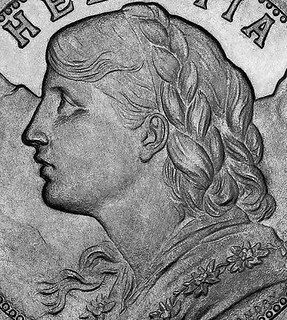 It is hardly an exaggeration to say that every Swiss person, young or old, knows what a Vreneli is and that almost every Swiss household has at least one copy of this gold coin. There are many unexpected stories and special features in this coin that are unknown to the layman and make this coin particularly exciting.
It is hardly an exaggeration to say that every Swiss person, young or old, knows what a Vreneli is and that almost every Swiss household has at least one copy of this gold coin. There are many unexpected stories and special features in this coin that are unknown to the layman and make this coin particularly exciting.
Worldwide, the Vreneli is one of the few old coins that has remained popular in a modern society. Its endearing nickname ‘Vreneli', which is still used today as it was 100 years ago, further underlines this unique relationship. Perhaps this special relationship in the unconscious can also be explained by the fact that the Vreneli was presented to good children in Switzerland for generations with benevolence as a godfathers' gift for baptism and as a Christmas or birthday present. For the relationship is quite different in countries where gold coins had to serve as ‘nest eggs' in times of war and crisis. In other words, in times that we would rather leave behind and forget today.
To read the complete article, see:
The Swiss Vreneli
Switzerland's best-known and at the same time least-known gold coin
(https://www.lugdunum-numismatik.com/en/swiss-goldvreneli/)
GOLD DANIEL MORGAN COMITIA AMERICANA MEDAL
Last week we got a hint of an amazing discovery being offered by Stack's Bowers in their Spring 2022 sales - the only gold Comitia Americana medal in private hands. Cataloguer John Kralvevich Jr. kindly provided a copy of his lengthy lot description. With permission, here is an excerpt. -Editor
When a national treasure from the American Revolution was stolen in a brazen bank heist in 1818, a dutiful heir involved former President Thomas Jefferson and lobbied for an Act of Congress to replace it. This is the medal his decades of persistence achieved, the only example struck, the only gold Comitia Americana medal in private hands, and the only Congressional Gold Medal ever authorized by two separate Acts of Congress. Struck at the Philadelphia Mint in 1839 from dies fashioned in Paris, it is utterly unique. It is offered, here, at auction for the very first time, a majestic testament in gold to the debt owed this nation's first military heroes and the efforts to honor their legacy.
Struck in impressive relief and superlative detail, this medal is the finest medallic effort of its age and, perhaps, any other, taken from Dupre's original work from 1789. The devices stand in bold contrast to the deeply reflective fields on both sides, rising from the richest yellow gold. The Philadelphia Mint struck few gold medals in this era (this was the largest since the 1837 striking of the Col. George Croghan medal for the Battle of Sandusky), and special care was clearly taken in preparing its planchet and executing its striking. The centering is precise, and the details were raised by two exacting strikes, right atop each other but visible on both sides.
The dies were fresh and in their earliest die state, as expected, as the dies were produced for just one purpose: to coin this exact medal. Fine preparatory finishing and file marks in the die are seen on the border between the interior and exterior rim. Microscopic hints of spalling (sometimes incorrectly called die rust) are seen in the obverse exergue. A few lintmarks are seen, indicating the polishing of the dies prior to striking. The largest of them is between the tops of LI of DANIELI, but the most interesting of them appears on the edge. It takes a special medal to make sure the die faces are polished and clean, but it takes another order of magnitude to similarly prepare the collar to produce a bright and lustrous edge.
The beautiful original case, seen on other unique gold medals from this era (like the one made for Adam Eckfeldt in 1839), served its function perfectly. It not only presented this medal a dramatic backdrop fit for its historic stature, but preserved it well. The surfaces are watery, lustrous, bright, and free of contact marks. The edges are perfect and unflawed, and the devices show no evidence of wear.
Initially authorized in March 1781, just two months after the epochal battle in the upcountry of
South Carolina, the Morgan at Cowpens medal was among the medal projects left incomplete
by both Benjamin Franklin and David Humphreys as they came, and went, from Paris. Upon
Humphreys' departure in 1786, the as-yet-unfinished medals authorized by Congress became
the sole responsibility of Minister Plenipotentiary to France, Thomas Jefferson, assisted by his
secretary, William Short. I have made no contracts for the other four,
Humphreys wrote to
Jefferson on April 4, 1786, referring to the medal awarded to General George Washington as
well as the three designated for the Battle of Cowpens, to Lieutenants William Washington and
John Eager Howard, along with General Daniel Morgan. Jefferson contracted with Pierre-Simon-Benjamin Duvivier to accomplish the dies for George Washington's gold medal and the
silver medals for Howard and William Washington. For Morgan's medal, he contracted with the
leading name in French medallic art, Augustin Dupre.
Thomas Jefferson, recalled to the United States to serve as President George Washington's first Secretary of State, carried the gold medal for Gen. Daniel Morgan with him upon his return from Paris in September 1789. On March 25, 1790, Washington transmitted the glittering gold medal to Morgan, then living near the frontier town of Winchester, Virginia. Upon his death in 1802, it was carried to Pittsburgh by his widow and placed in the care of his son-in-law, Col. Presley Neville. Neville married Daniel Morgan's oldest daughter, Nancy, in 1782. They had 14 children, of whom Morgan Lafayette Neville was the oldest, born in 1783.
Morgan Neville and Pittsburgh's First Bank Robbery
Morgan Lafayette Neville grew up in Pittsburgh when the city at the forks of the Allegheny and
Monongahela was still on the frontier. As a young man, perhaps emboldened by the
adventuresome spirits of his father and maternal grandfather, Neville accompanied a small
group of Pittsburghers on what turned out to be the beginnings of Aaron Burr's traitorous
expedition of 1806-7. Chastised by the experience, he studied for the bar and became a model
citizen: attorney, banker, and journalist. He even served a term as Pittsburgh's sheriff. He
gained his greatest renown as a newspaperman while editor of the Pittsburgh Gazette, penning
works of fiction like The Last of the Boatmen,
which some consider foundational among
Western and pioneer-themed American literature. Neville enjoyed a national reputation in his
adult life: well-connected politically, wealthy and well-educated, a leading figure in the history of
Pittsburgh and Cincinnati, where he lived his last decades.
Neville was the cashier of Pittsburgh's Farmers and Mechanics Bank when disaster struck on
April 6, 1818. The bank was burglarized in the middle of the night by means of false keys, and
a large amount in notes and specie stolen therefrom,
according to Neville's Pittsburgh Weekly
Gazette.
Neville's entire patrimony and life savings was gone. His bank closed down, unable to do business. Morgan's gold medal was foremost among the relics left to his young namesake, an item of importance to both his family and the nation, and an object of great value too. Neville's bank offered a huge reward for the return of what was stolen: first $1000, then $3000 for the loot and $1000 for the capture of those responsible.
The medal was never recovered.
Morgan Neville steadfastly lobbied Congress for a replacement for the lost medal, a request that was ultimately granted, but it took years more to have it struck. -Editor
Morgan Neville died on March 2, 1839. He never saw the medal. His lifelong quest for absolution in losing the ultimate family heirloom ended unrequited. But his legacy carried on: through his namesake son and proud string of descendants, through his written works, and through his long-lasting reputation as one of the founders of American pioneer fiction.
Secretary of War John Bell, after some delay pondering the medal's rightful owner, presented the renewed Daniel Morgan at Cowpens medal to Neville's son, Morgan Lafayette Neville, Jr., on September 11, 1841. Upon his death in 1855, the medal passed to his son Jesse, then just a child. Perhaps because he grew up without his father, Jesse Neville cherished the medal. He even put it on display in a jewelry store window in Saratoga, New York, his summer vacation destination, in August 1885.
At some point after 1914, the medal passed out of the family. According to the history of this medal given to us, it was acquired from a descendent of J. Pierpont Morgan, Jr. Morgan, the wealthy banker and heir to both his father's fortune and philanthropic sensibilities, formed immense collections, many of which have since become part of the Metropolitan Museum of Art. Morgan, we are told, acquired the medal in the hopes that Daniel Morgan was an ancestor, but upon discovering no familial connection, decided it was no longer appropriate for the family holdings.
Stack's Bowers Galleries has been fortunate to set the world record for American historical medals with unique Congressional Gold Medals on two occasions. First, in 2006, Gen. Zachary Taylor's 1848 Congressional Gold Medal awarded for the Battle of Buena Vista in the Mexican- American War brought $460,000. It was the first Congressional Gold Medal to cross the $100,000 barrier, and the highest realization for a Congressional Gold Medal since Anthony Wayne's medal for the 1779 Battle of Stony Point brought $51,000 in a 1978 Sotheby Parke- Bernet sale. More recently, in August 2021, the Congressional Gold Medal awarded to Gen. William Henry Harrison for the 1813 Battle of the Thames brought $600,000 at public auction, setting a new high-water mark for a Congressional Gold Medal.
The only silver Paris Mint Daniel Morgan at Cowpens medal in private hands brought $115,000 in our November 2019 sale of the John W. Adams Collection. It had once been the world record holder for an American historical medal, bringing $80,500 in May 2001. Four Paris strikes of the Morgan medal in copper remain in private hands. Two of those medals were included in the Adams Collection, bringing $55,200 and $78,000. The Adams Collection included no silver strikes from the 1839 Morgan dies (or this unique gold strike, of course), but a silver strike from these dies in our November 2021 sale brought $33,600.
What an amazing numismatic treasure, with a fascinating backstory. Way back in 2003, John spoke at the annual banquet of the Pennsylvania Association of Numismatists about the original medal, the bank robbery, and the mystery of the missing replacement medal, which hadn't been seen or heard of since that 1885 display. And here we are in 2020, and the medal ended up with John to catalog. What a great treat! -Editor
John adds:
"I had no idea the medal struck by Act of Congress to replace the one tossed into the Ohio by the thieves would ever turn up, let alone end up on my desk.
"This is absolutely the coolest out-of-the-woodwork medal I've ever gotten to handle."
To read the earlier E-Sylum article, see:
GOLD MORGAN COMITIA AMERICANA SURFACES
(https://www.coinbooks.org/v25/esylum_v25n09a34.html)
PRINCE, THE WATCHDOG OF THE BANK
Perhaps Daniel Morgan's medal would never have been stolen had Pittsburgh's Farmers and Mechanics Bank had a top-notch watchdog on duty. This blog article by Loren Gatch explores the legacy of Prince, the watchdog mascot of the Farmers Deposit National Bank of Pittsburgh. Found via News & Notes from the Society of Paper Money Collectors (Volume VII, Number 36, February 22, 2022). -Editor
ANIMALS APPEAR in a wide variety of situations and motifs on fiscal paper. Livestock and other ruminants typically serve to illustrate agricultural bounty or evoke pastoral settings. Some animals symbolize a place itself, like the otter on checks from the Bank of Otterville, Missouri. Robert Eberhard Launitz's statue of Leatherstocking, which appeared for decades on checks of the First National Bank of Cooperstown, N.Y., depicts Natty Bumppo and Hector, the hunting dog gazing up in abject adoration at his master. Otherwise, canines are often used to portray some behavior or attitude that we value in banking and finance: loyalty, protectiveness, and vigilance. Variations on the vignette of a dog, perched upon a strongbox and guarding its key, are perhaps the most characteristic expressions of these traits.
For the most part, these dogs were at best anonymous models for the engraver's art. Not so with Prince, the English bull terrier gracing this check drawn in 1906 on the Farmers Deposit National Bank of Pittsburgh, Pennsylvania. Prince not only existed, but bestrode the lobby and corridors of that Pittsburgh bank for the better part of the 1890s. Originally a gift to the bank's cashier and later president, T. H. Given, Prince became a denizen of the bank, wandering its premises freely as a gentle friend to children and a fierce foe of enemies.
Although the dog disappeared mysteriously in 1898, the memory of Prince lived on and was indeed burnished as an icon of the bank's corporate identity. Images of Prince appeared not only on checks, calendars, stationery, and other documents of the bank, but on its stock certificates themselves. When Given had the new Farmers Deposit Building constructed in 1902, it was the tallest skyscraper between New York and Chicago. Given also made sure it was embellished with a variety of Prince-inspired ornamentation, making his new skyscraper a veritable temple to the departed dog. The bank's thrift affiliate, the Farmers Deposit Savings Bank, also made enthusiastic use of the animal's likeness in its marketing, ensuring that Prince became an internationally-recognized symbol. For a good half century after his departure, Prince represented a venerable Pittsburgh financial institution to its customers far and wide.
The origins of the Farmers Deposit National Bank lay in the founding, in 1832, of the Pittsburgh Savings Fund. This was a simple mutual savings society in which members contributed small regular subscriptions. In 1841 it incorporated as the Farmers Deposit Bank and continued that way for almost twenty-five years until it reorganized under the National Banking Act as the Farmers Deposit National Bank (charter no. 685). In 1880, Thomas Hartley Given (1851-1919) became Cashier of the bank, assuming the post of President in 1893.
Prince's story, which was recounted numerous times over the years, has the feel of a polished stone of corporate public relations. Nonetheless, there is no harm in treating the basic details of his life as if they were true. Prince, a white English bull terrier, came to the bank in the summer of 1889 from Henry Kramer, a traffic officer who worked at the corner of Fifth Avenue and Woods Street in downtown Pittsburgh (Kramer, who had just started with the force, later drove the first horse-drawn police patrol in the city and had a long career fighting crime). At the time, the bank was located at 400 Fourth Street. T. H. Given, at that time still Cashier, was a serious dog-fancier who maintained his own kennels and was active on the show circuit (a Chihuahua of his, Carlotta
, won a First Place at a Pittsburgh show in 1899). In addition, during these years Given not only served on the executive committee of the Bull-Terrier Club of America, but hosted its meetings on the bank's premises.
Although Prince had no pedigree, Given took a liking to the animal, and it thereafter became a mascot and constant fixture of the bank for the next nine years. Prince's actual care was left in the hands of Chatham Gilbert, an African-American porter who in time would become the bank's oldest and longest-serving employee. It was left to Gilbert to feed Prince twice a day, and make sure that the dog got the exercise it needed. Otherwise, Prince had free range of bank's rooms and corridors. When the dog was not making these rounds in this way, he parked himself outside of the bank's steel vault. At night, Prince slept on a pillow placed in front of one of the bank's windows overlooking Fourth Avenue.

In this picture from about 1890, Farmers Deposit National employees pose with Prince.
Figure at the far left is probably Chatham Gilbert (Source: Historic Pittsburgh).
Accounts of Prince's temperament, handed down over the years, made much of his friendly disposition towards all customers and his particular solicitude for young children, whom he was said to shepherd while their parents were busy filling out forms and transacting business. Over two decades after Prince finally disappeared, the bank put out a twenty-page booklet entitled The Story of Prince, in which the dog was described thus: full of life and mischief, with bright intelligent eyes, always unselfish, faithful and true. Children were sure to find in him an affectionate and devoted friend.
No doubt this was some publicist's florid copy. All the same, it is unlikely that a bank would've let its mascot roam like that if it did have a habit of mauling its little customers. To that extent, the story of Prince can be accepted as not disproven. Indeed, Prince comes off as something like the noble dog
in Plato's Republic, gentle towards those it knows but fierce towards its enemies.
While over the years Prince kept to his routine, it was not an uneventful life. Prince stood up for himself in fights with other dogs in the neighborhood, giving as good as he got. As the bank's mascot, he represented it at various sports events when the Farmers' Deposit men would play teams from other companies. One baseball match in particular became a regular part of Prince lore. As recounted by Edward B. Coll, a longtime bank officer, it was ninth inning, two men on, two men out, one run needed to win. The player hit a fly ball to left field. Prince got away from the colored fellow that was holding him and started to run. The left fielder thought that Prince was after him, dropped the ball, and ran away—and the Farmers won the ball game.
I remember Prince well from my days collecting the banking memorabilia of Pittsburgh, my home town. I believe I still have some of these savings checks.
Great article. Many thanks to Loren Gatch for not only highlighting Price, but shedding some light on his caretaker Chatham Gilbert. -Editor
Loren adds:
"One thing I wish I'd found was a photograph of the dog's head as it was installed over the bank's main entrance. That must have been pretty wild to look at.
"When I was researching this, I did notice that, about fifteen years ago, somebody was advertising in Pittsburgh papers to purchase any Prince-related memorabilia. So there must be an expert on the "Prince" story out there somewhere!"
Perhaps the Prince collector is among our readers - we have many subscribers among the Pennsylvania Association of Numismatists (PAN) and Pittsburgh-based Pennsylvania Area Token Collectors Organization (PATCO). -Editor
To read the complete article, see:
Prince, The Watchdog of the Bank
(https://spmc.org/blog/prince-watchdog-bank)
THE MONEY FORGER HONORED ON A BANKNOTE
Here's an interesting story from Australia about a forger whose face ended up on a banknote. -Editor
I didn't realize I was carrying the face of a criminal in my wallet for many years. And so were most people in Australia. The face was that of Francis Greenway, a convict sent to Australia for financial forgery who became one of the most highly respected architects in Australian history—so respected that his face was chosen to appear on the $10 note. He is the only convicted forger in the world depicted on a banknote.
Greenway was born in the United Kingdom in 1777.
He came from a family of architects, builders, and stonemasons and followed in their footsteps, training under the well-respected British architect John Nash.
Greenway set up a thriving architecture business in the city of Bristol, where he designed several important buildings. This included the Clifton Club — the only one of his buildings in the United Kingdom that remains.
However, in 1809, one of Greenway's most significant projects collapsed, sending his business bankrupt. This forced him into taking desperate action — he decided to forge financial documents.
A death sentence or a clever ploy?
In 1812 Greenway faced court for his forgery — a crime punishable by death.
In order to reduce the sentence, Greenway pleaded guilty to the crime, and his sentence was commuted to transportation for 14 years to the colony of New South Wales in Australia. This was a typical sentence at the time as the British wished to populate their new territory on the other side of the world, and the best way for them to do this was with prisoners.
Greenway arrived in Sydney in February 1814 to commence his 14-year sentence. He brought with him letters of recommendation and his architectural portfolio so he could rebuild his career.
This leads to an interesting theory.
Australia was growing quickly during this period, and some historians believed that Greenway deliberately got caught.
It was a considerable risk — if it backfired, he would have been hung, but it paid off.
He took out an advertisement in the Sydney Gazette offering his architectural services and also sent his resume — so to speak — to the Governor of New South Wales, Lachlan Macquarie.
The convict designing Sydney
Greenway's first project was the design and construction of the Macquarie Lighthouse. This was deemed a huge success and resulted in Governor Macquarie emancipating Greenway. Having the lighthouse named after him probably helped also.
Greenway was now a free man.
Dropping the word convict from his profile seemed to lift Greenway to greater heights, and his work across Sydney continued at a rapid pace. He was responsible for the Hyde Park Barracks, parts of Government House, the Supreme Court, and St.James Church.
These remain some of Sydney's most iconic buildings two hundred years later.
Greenway became known for his extravagance and his huge, overblown budgets. His designs were so grand that when he built the horse stables for Government House, it was mistaken for the actual Government House residence.
Forty-nine buildings in central Sydney are attributed to Greenway's designs, and St. James Church was chosen as one of Australia's only two man-made ‘treasures' by Dan Cruickshank in the BBC series Around the World in 80 Treasures.
But perhaps his finest honor was being represented on the 10 dollar note from 1966 until 1993.
To read the complete article, see:
The Money Forger That Was Honored By Becoming The Face On A Banknote
(https://historyofyesterday.com/the-money-forger-that-was-honored-by-becoming-the-face-on-a-banknote-ec6cd30b4789)
CHINESE MAN SPENT HAND-DRAWN BANKNOTES
Like my old friend J.S.G. Boggs, a man in China spent hand-painted, home-made banknotes. -Editor
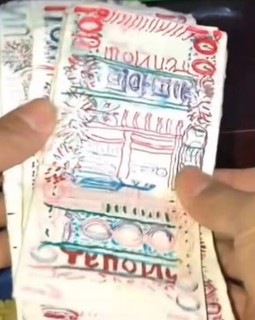 In 2020, a short video on Douyin, China's version of TikTok, of an elderly man clad in rags and struggling to communicate his desire to buy noodles brought the man, Zheng Zulong, and the noodle store owner Guose Li, instant fame.
In 2020, a short video on Douyin, China's version of TikTok, of an elderly man clad in rags and struggling to communicate his desire to buy noodles brought the man, Zheng Zulong, and the noodle store owner Guose Li, instant fame.
Misfortune, on the other hand, always seems to find its way to the already downtrodden. Zheng died in a drunk driving accident in January of this year, breaking the hearts of many people online.
May he no longer live a wandering life in heaven,
a person commented.
Zheng was left mentally disabled in an accident when he was a small child. He never married, and his only family is a nephew with whom he has never been close.
According to Li, Zheng used to buy the noodles using a few crumpled bills he found on the road or in the rubbish. However, since the wet market was demolished and rebuilt five years ago, he ran out of money at times.
He still went to Li's store regularly. Instead of paying with real money, he handed Li fake, hand-painted bills.
My wife laughed when she saw the hand-drawn bills mixed in with the real ones the first time he took them out because they looked like a child's hand painting,
Li told the South China Morning Post.
No matter if the notes were real or hand-drawn, Li and his wife always accepted the bills and gave Zheng a day's supply of noodles. Li understood that the man just wanted some food.
I gave him free noodles earlier, but he rejected the offer; he had his rules, so I was happy to sell him the noodles this way,
Li said.
To read the complete article, see:
Chinese mentally disabled man famous for buying noodles with hand-drawn banknotes in popular online videos dies
(https://www.scmp.com/news/people-culture/trending-china/article/3168950/chinese-mentally-disabled-man-famous-buying)

